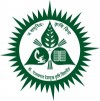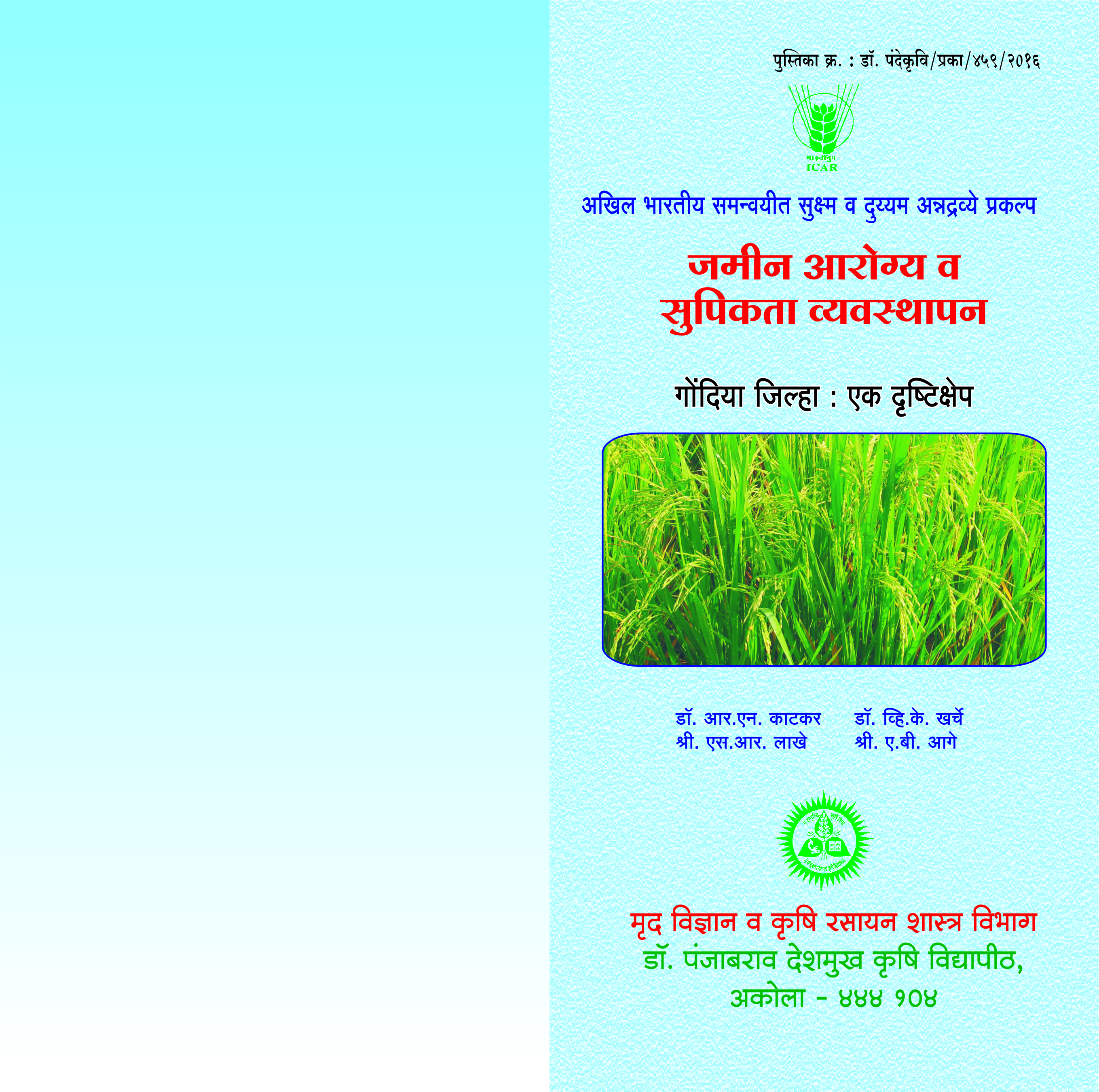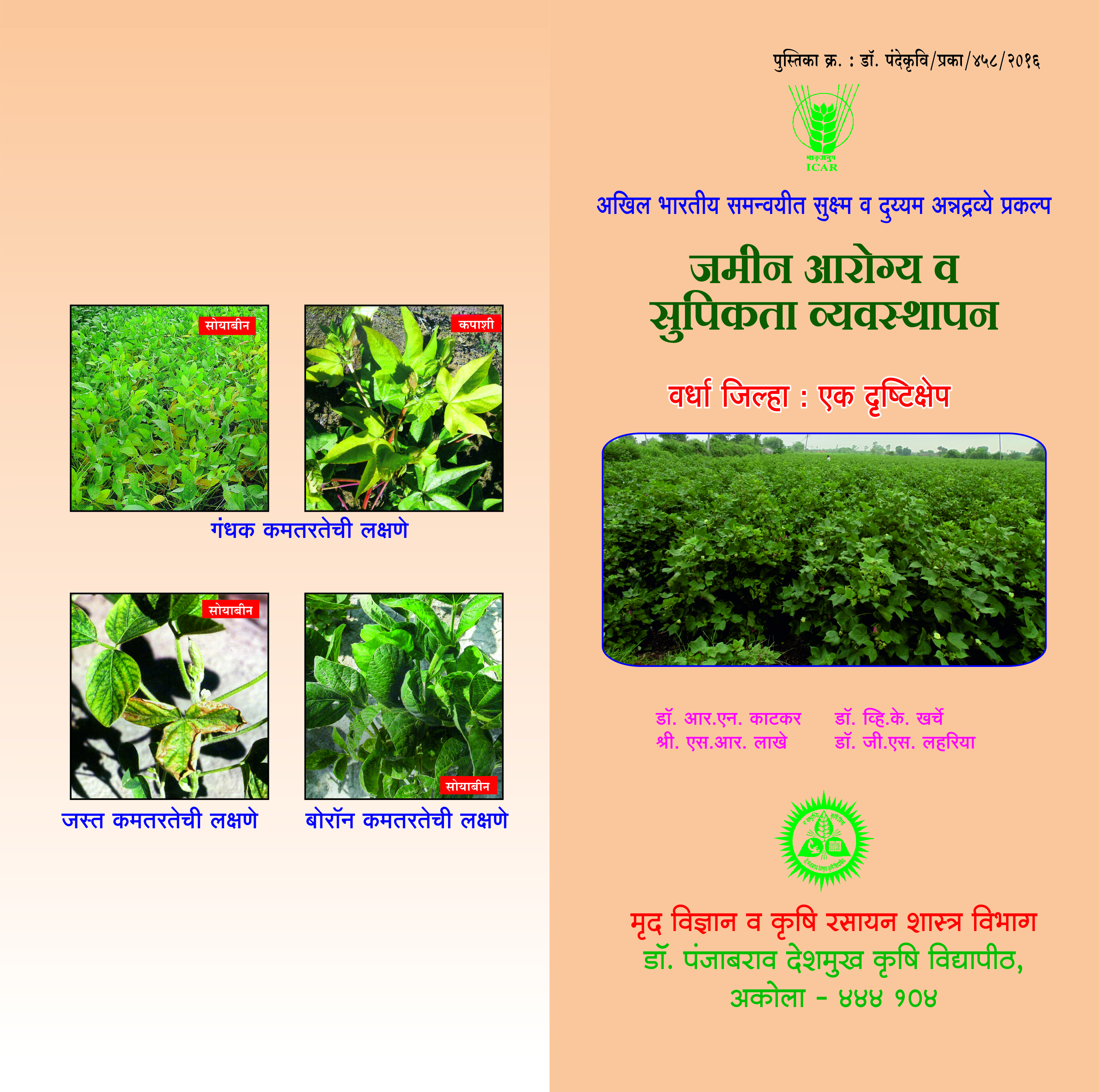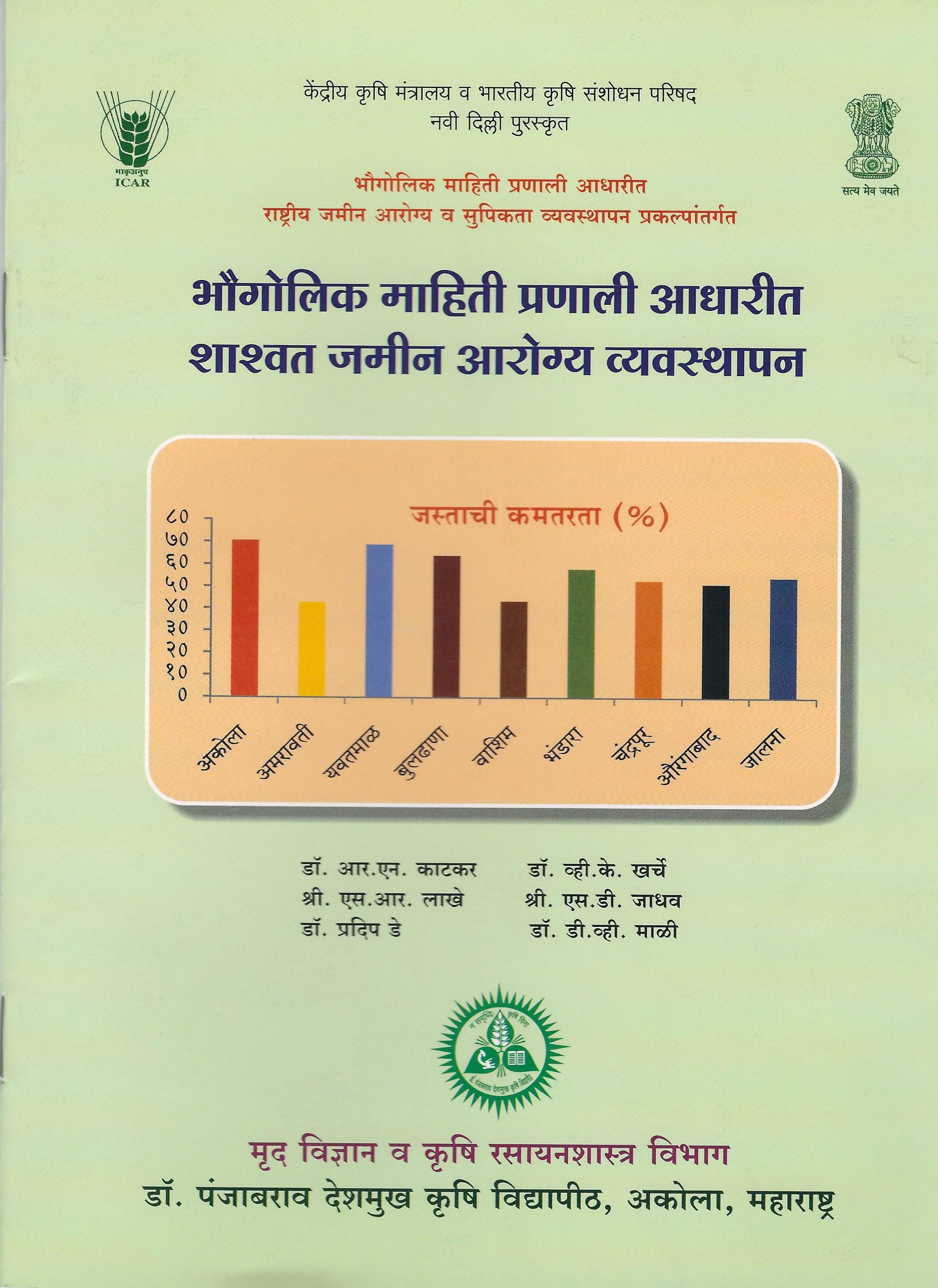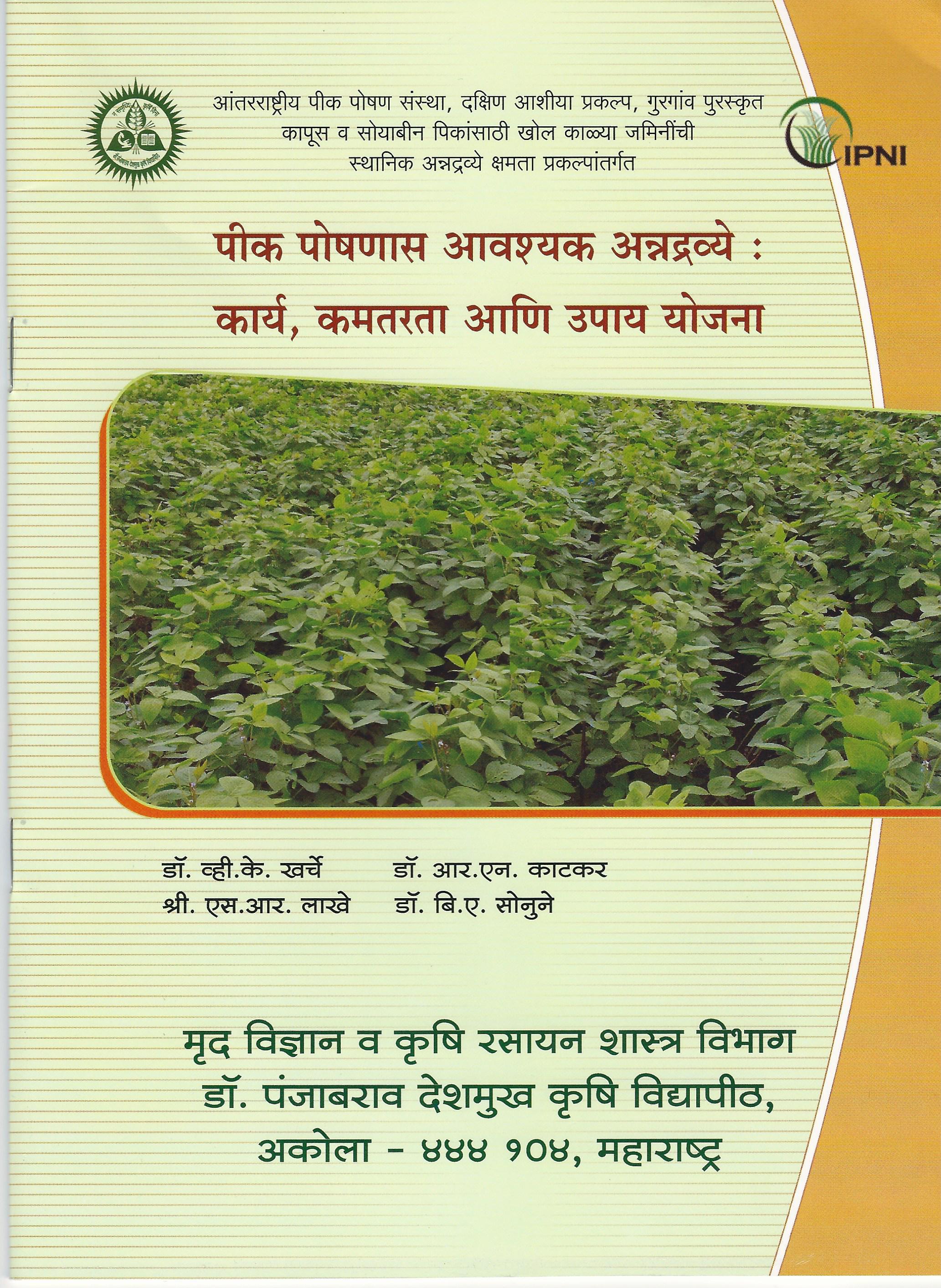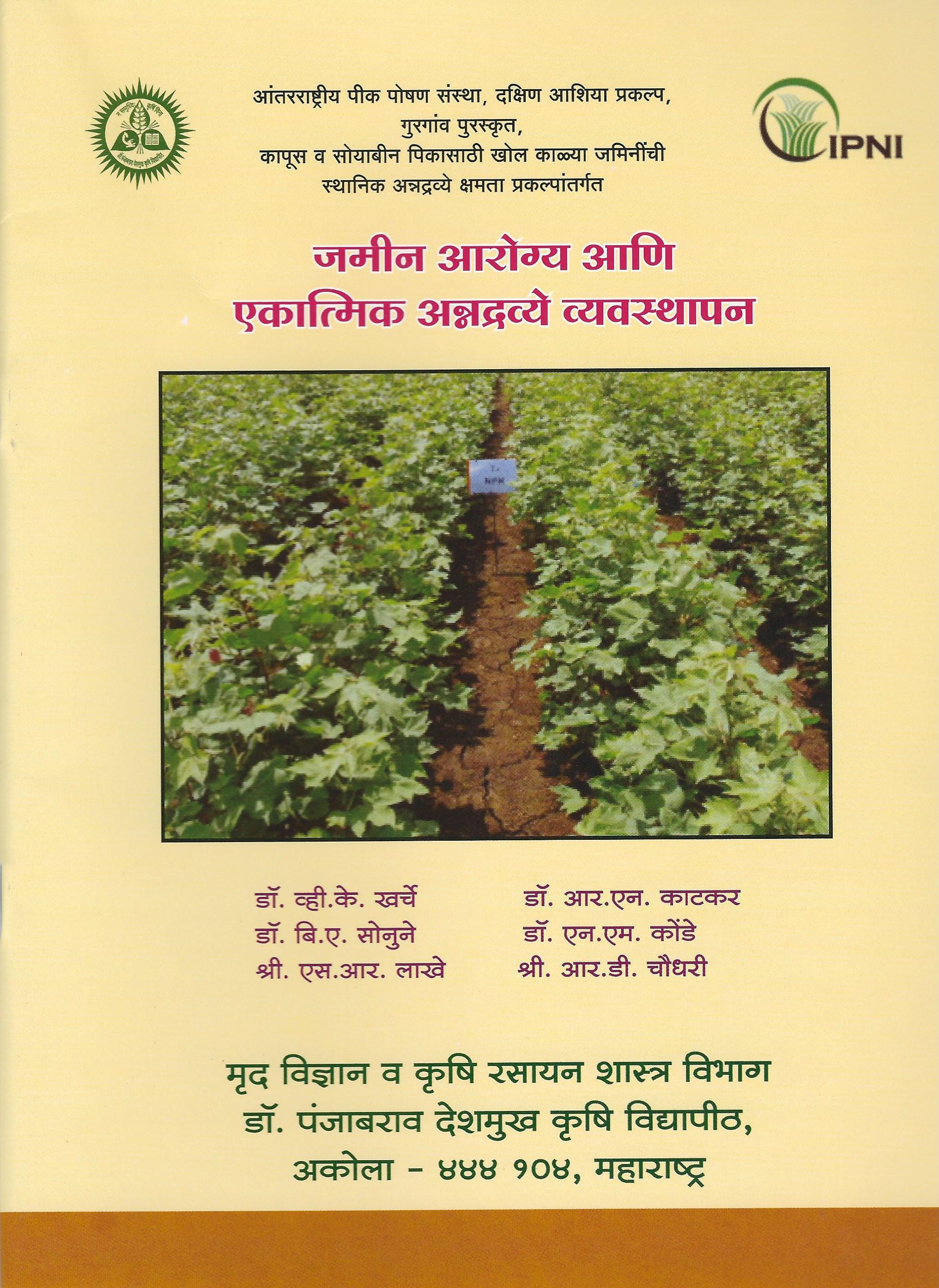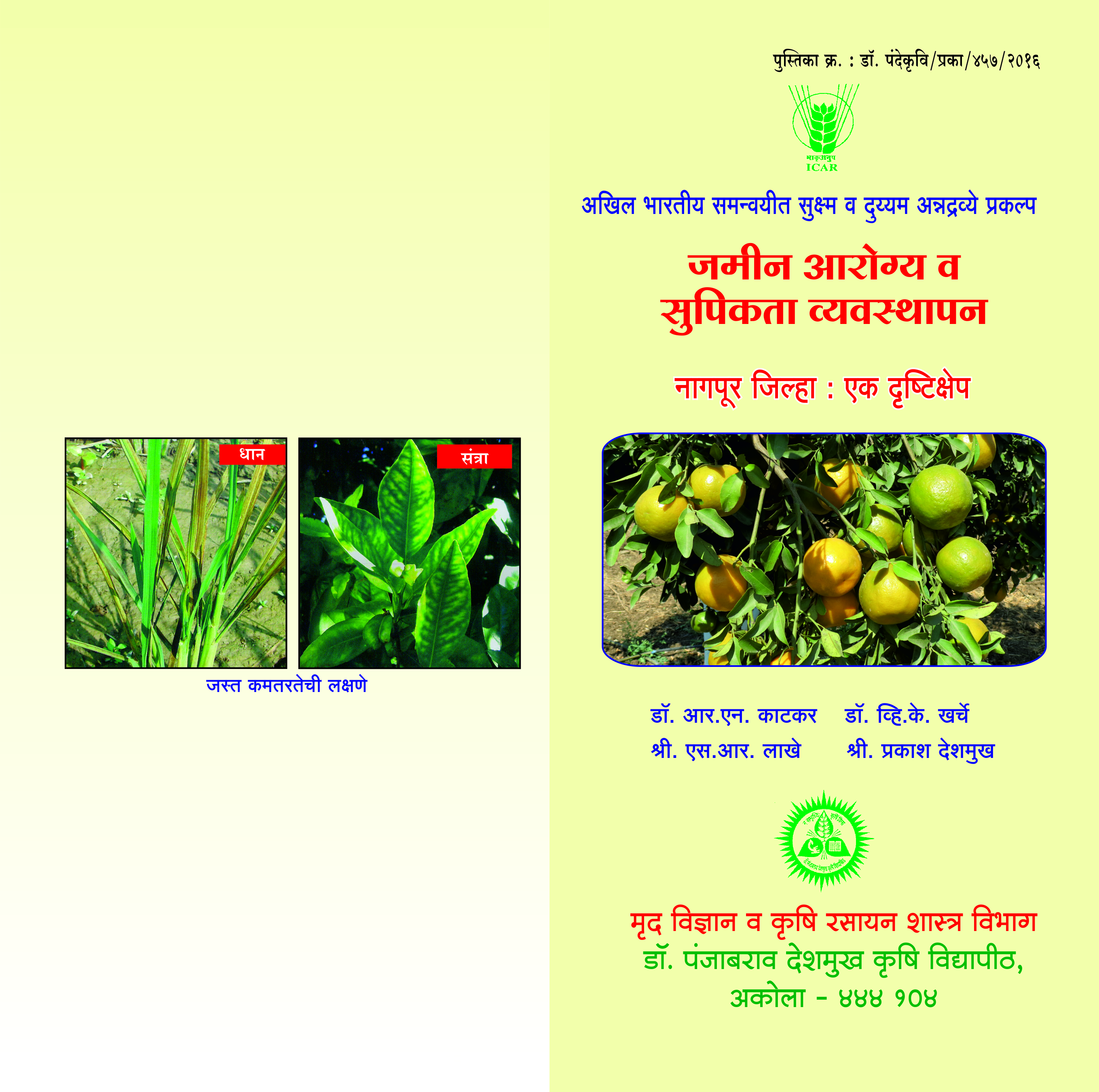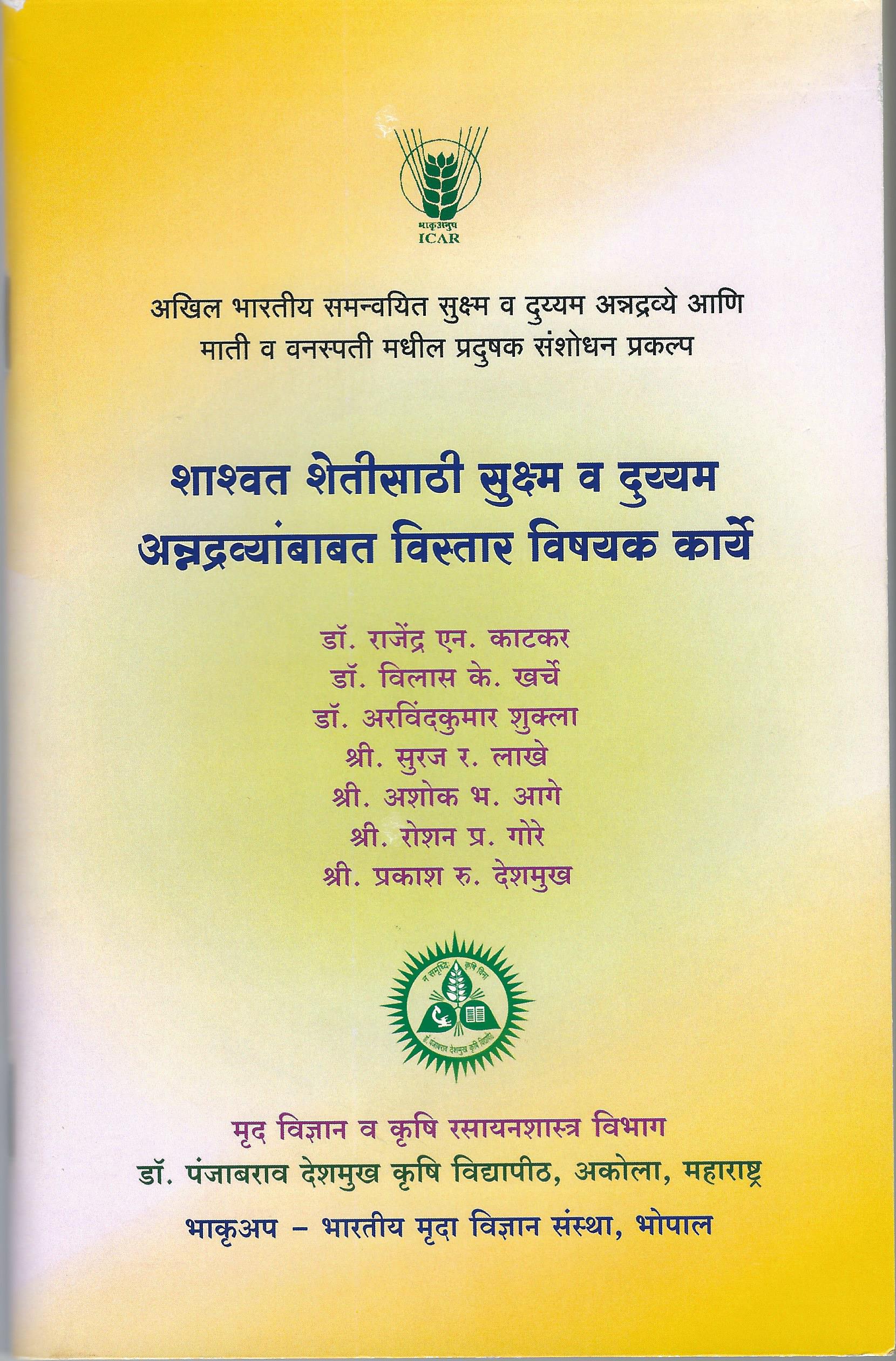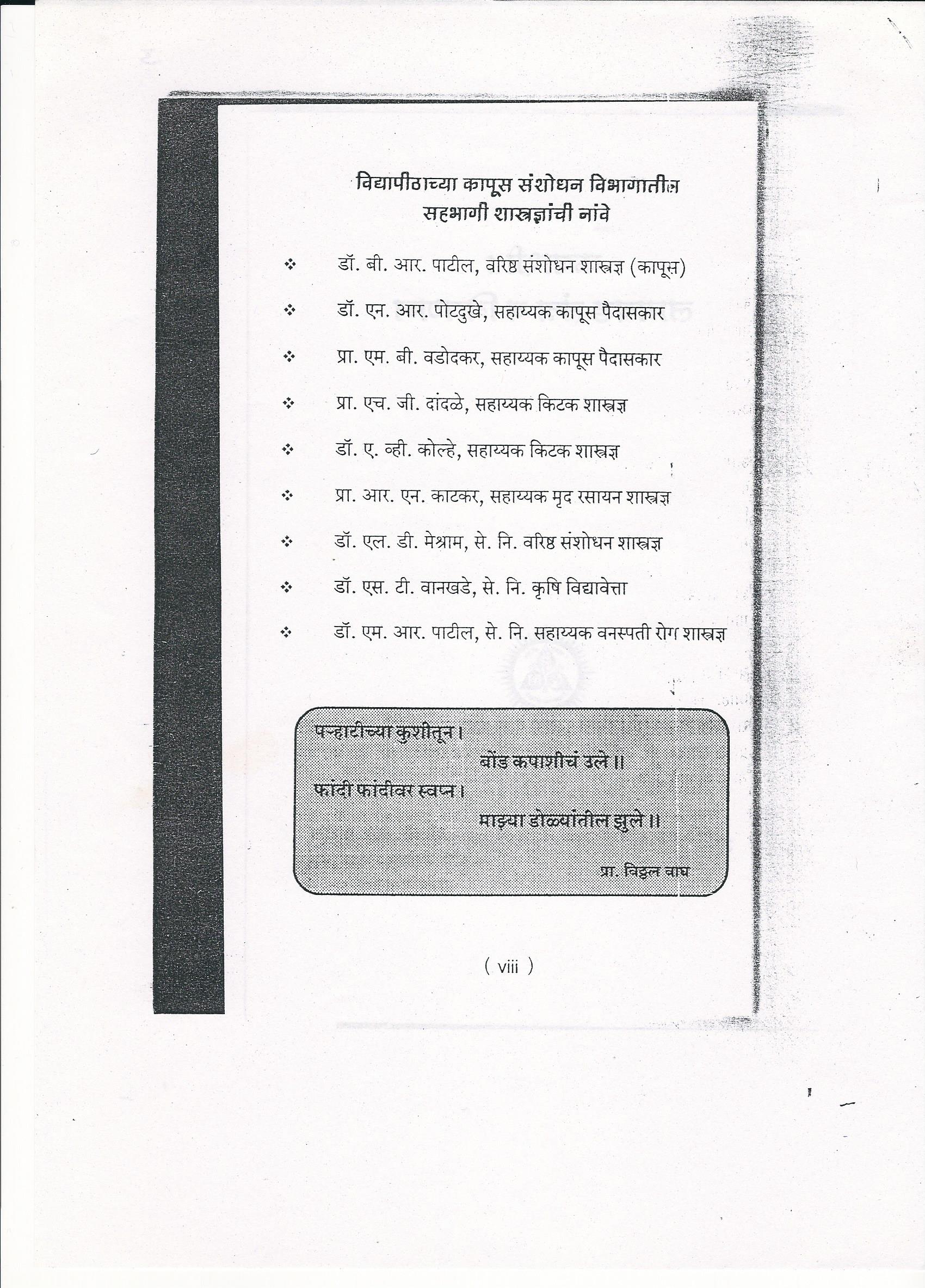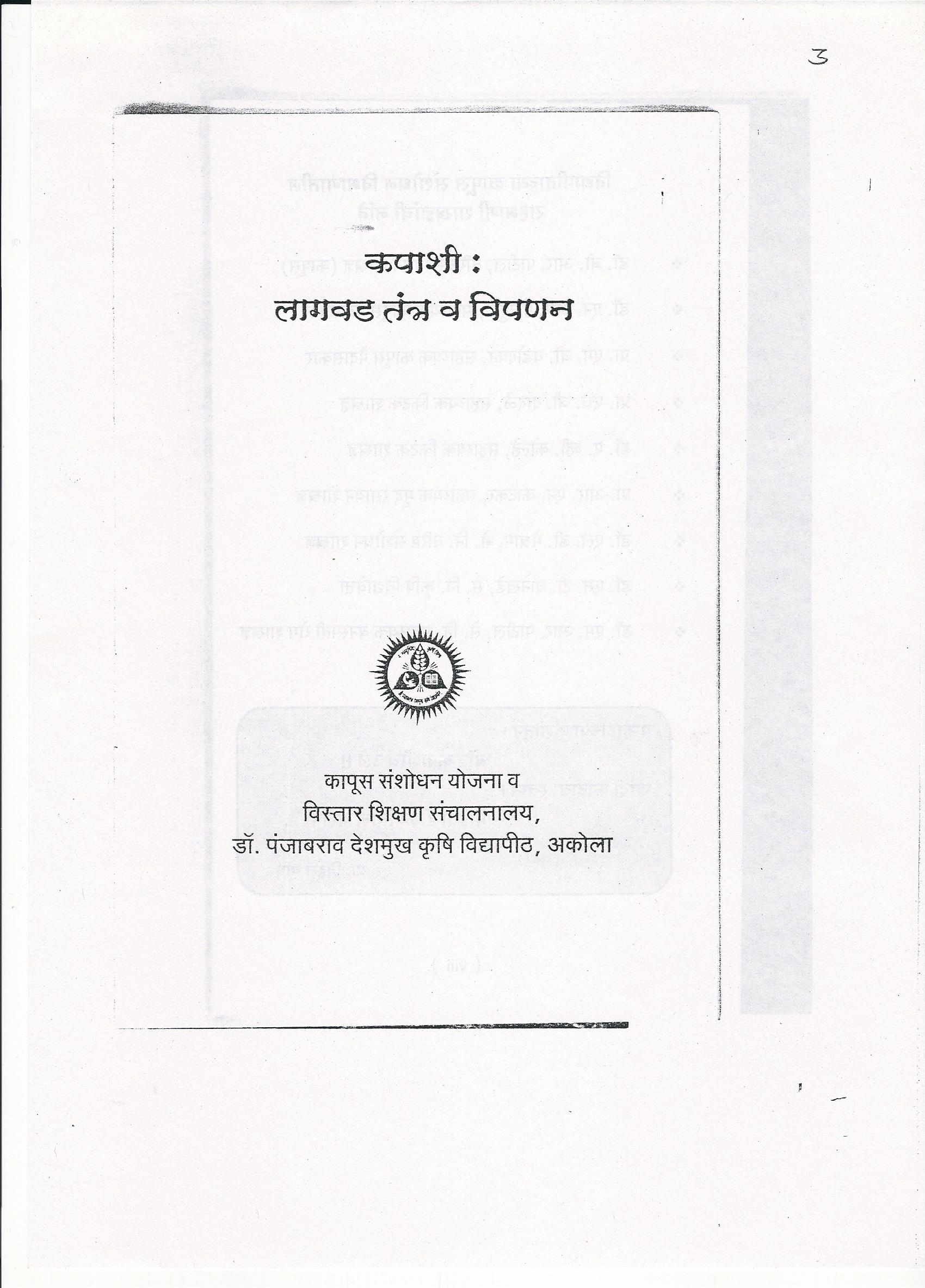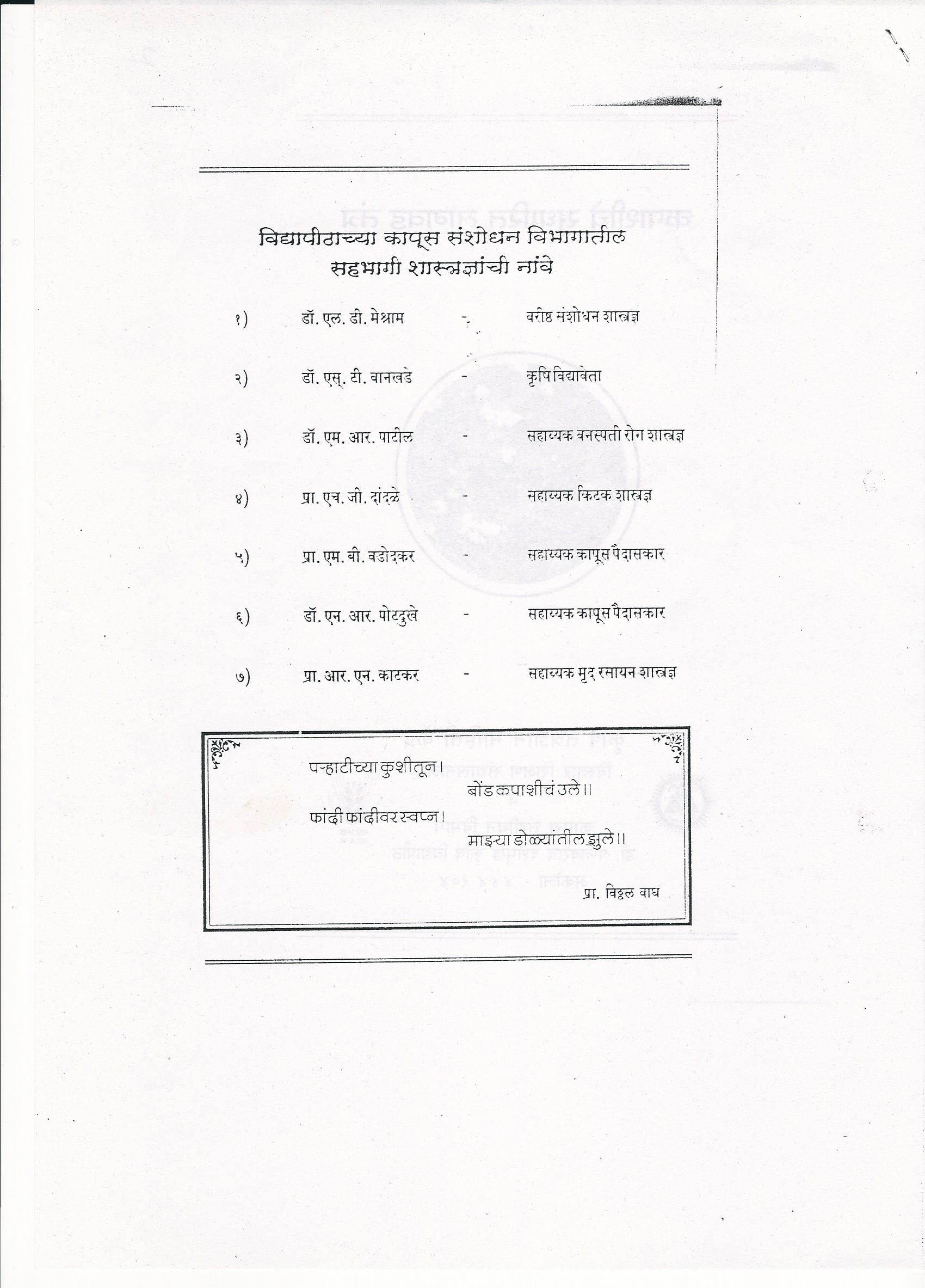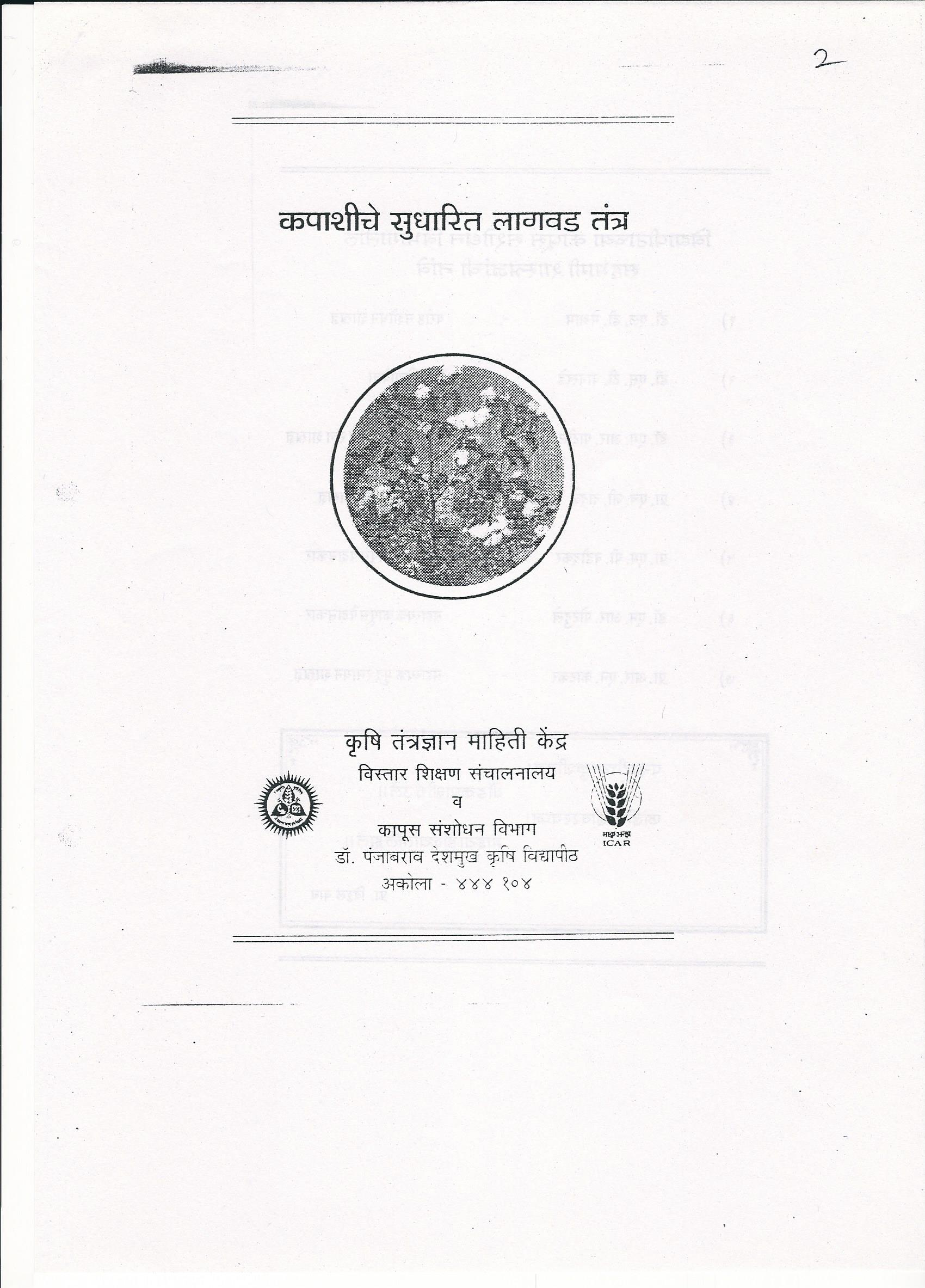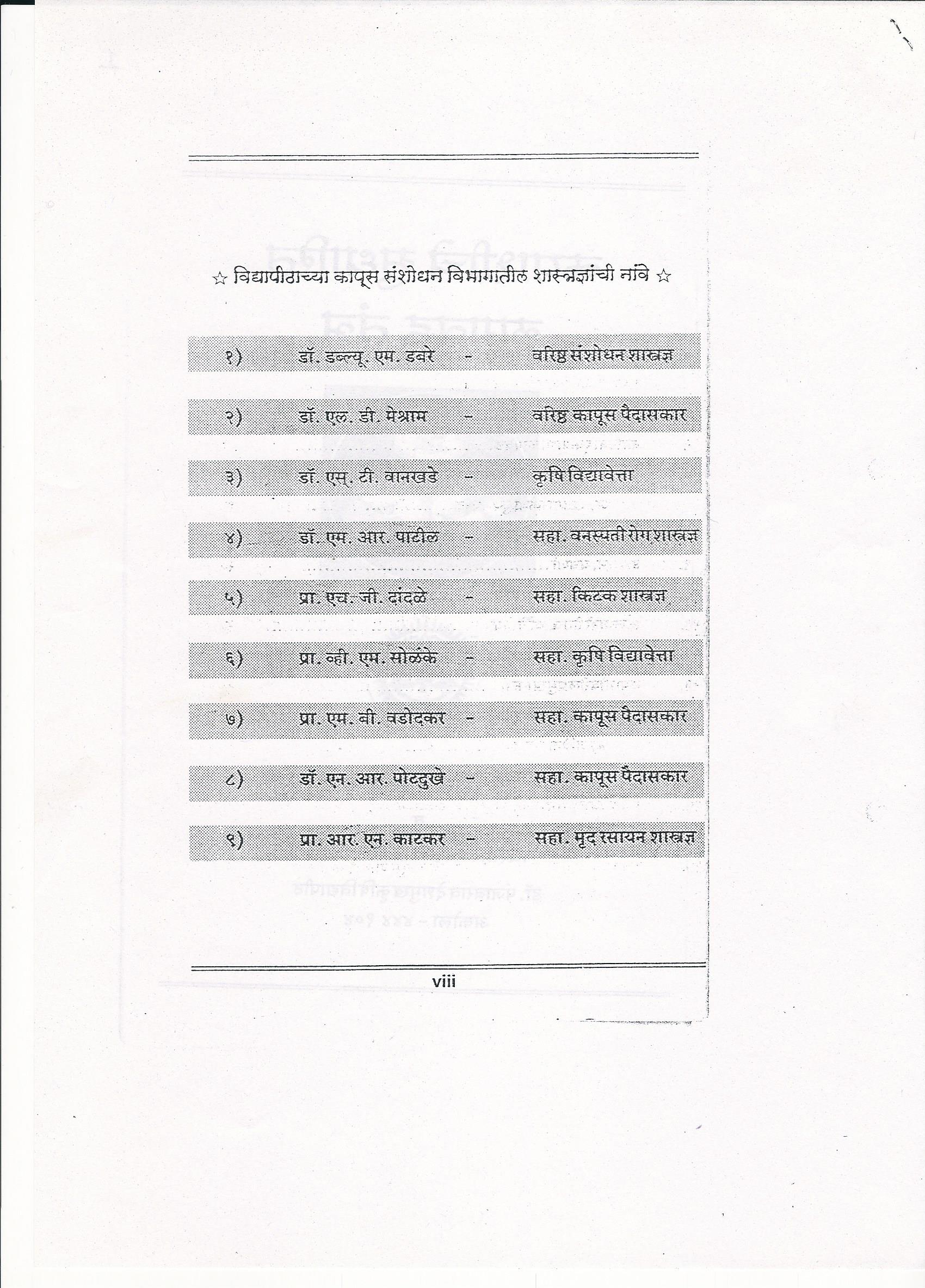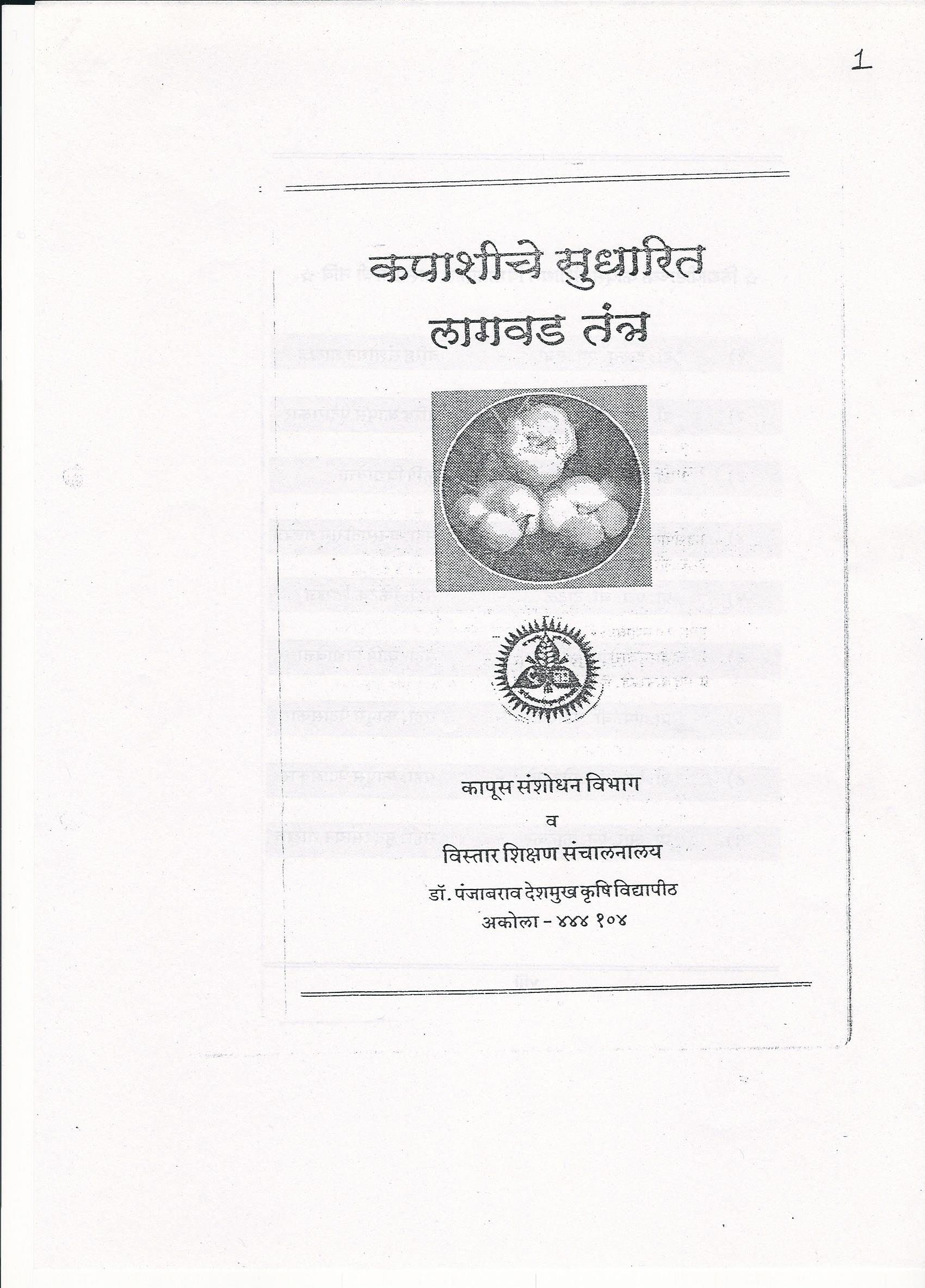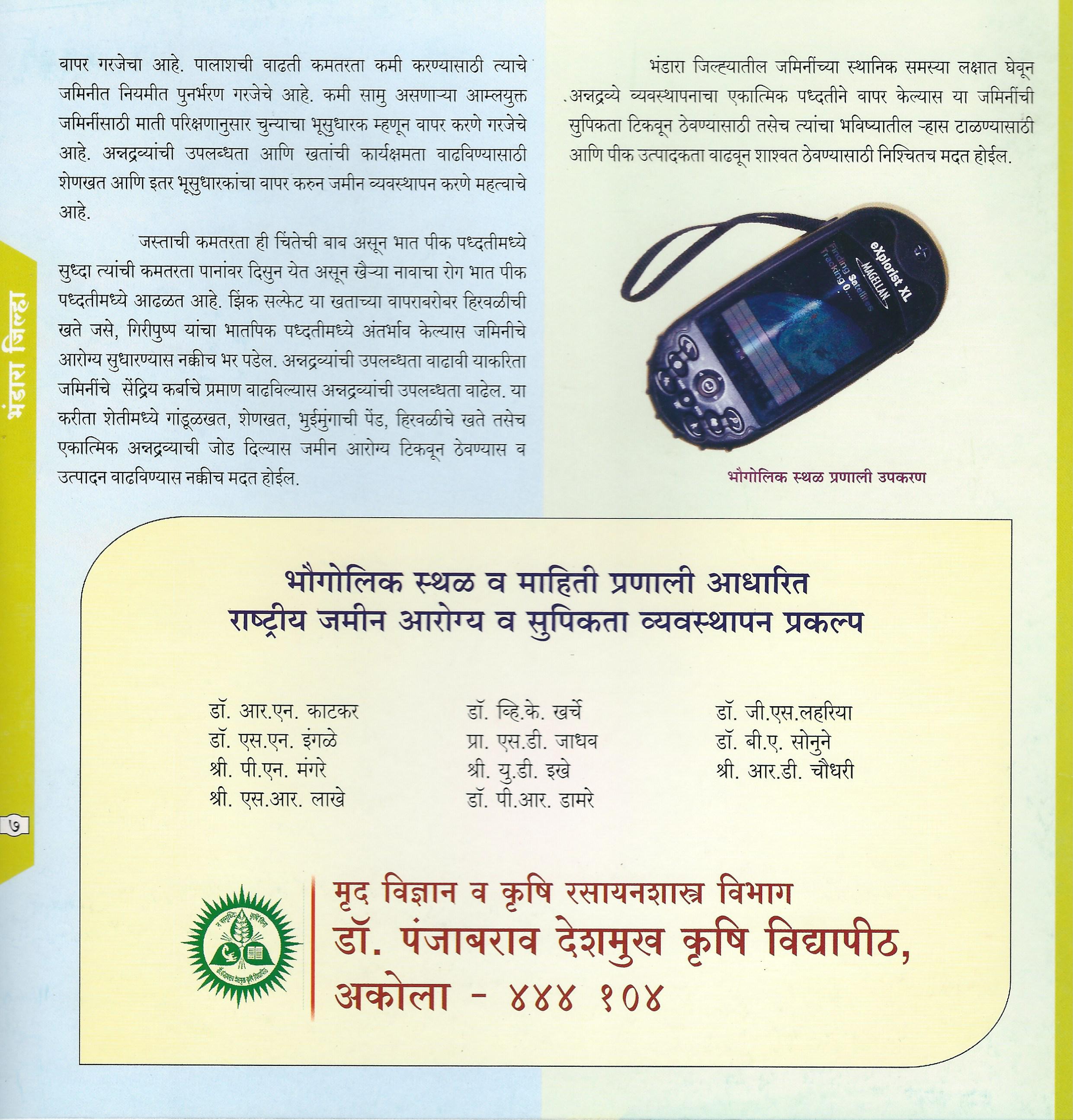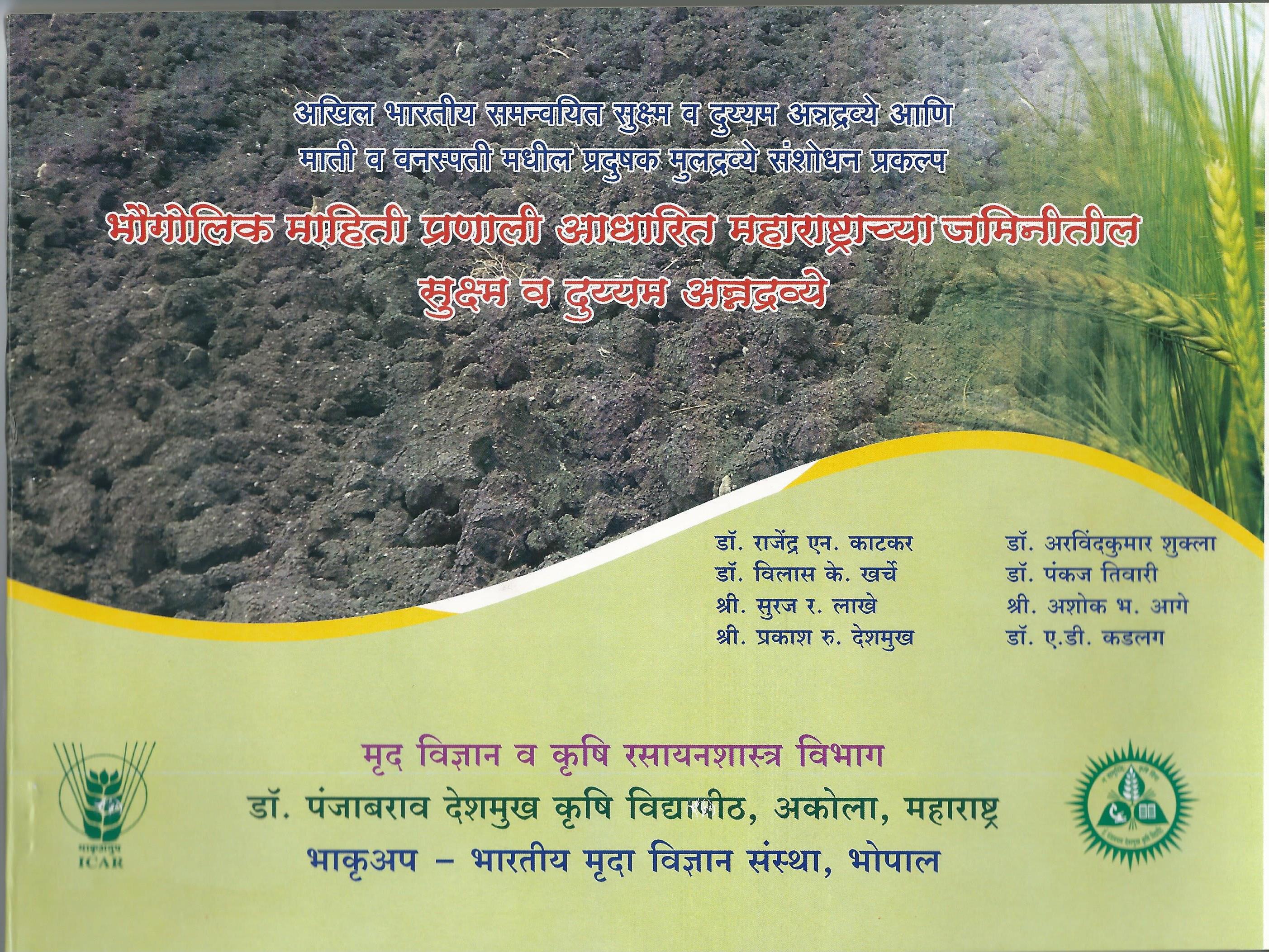| About Project | 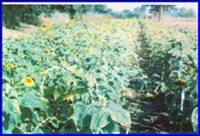 |
||
| Agroclimatic Information | |||
| Infrastructure Facilities | |||
| Mandate | |||
| Scientists | |||
| Research Activities and Achievements | |||
| Research and Extension Linkage | |||
| Publications | |||
| Contact Information |
About Project
The intensive cultivation of high yielding modern crop varieties, in the past few decades’ increased the crop productivity. However, this has resulted into emergence of micro and secondary nutrients deficiency in most of the soils, causing reduction in yields. In order to delineate the micro and secondary nutrient deficient areas and to alleviate the nutrition stresses, the Indian Council of Agricultural Research initiated the All India Coordinated Scheme of Micronutrient in Soil and Plants in 1967.
There are sixteen cooperative and five voluntary centers of this project in the country. A centre for Maharashtra state was initiated at Dr. PDKV, Akola in 1996.
The deficiencies of secondary and micronutrients and toxicities of heavy metal elements were subsequently noticed in many parts of the country. In view of this, the project mandate was expanded. The name of the project was modified to All India Coordinated Project of Micro and Secondary Nutrients and Pollutant Elements in Soils and Plants.
The Coordinating unit is functioning at Indian Institute of Soil Science, Bhopal. The centre at Lucknow is involved mainly in physiological research on micronutrient nutrition of plants while the remaining 19 centres concentrate their researches on the micro and secondary nutrient and pollutant elements in soils and plants.
Jurisdiction of the project
Maharashtra State represents four major regions viz; Vidarbha, Marathawada, Western Maharashtra and Konkan and there are four agricultural universities in these regions. Indian Council of Agricultural Research, has given the centre of “All India Coordinated Research Project on Micro and Secondary Nutrients and Pollutant Elements in Soils and Plants” at Dr. Panjabrao Deshmukh Krishi Vidyapeeth, Akola to carry out the research work on micro, secondary and pollutant elements in soils and plants in the Maharashtra state.
Faculty Information:
Dr. R. N. Katkar, Professor and Incharge
Dr. S. S. Hadole, Junior Soil Scientist
Shri. P. R. Deshmukh, Agril. Assistant
Shri. P. K. Chavan, Lab Attendant
Shri. S. R. Lakhe, Research Associate
Agro Climatic Conditions
The state has humid to per humid type climate in Konkan and western ghats, semiarid type in central and western Maharashtra, while sub-humid type in eastern part of the state. The annual rainfall in the state varies from 450 mm in the rain shadow area to 6000 mm in western ghats of which 80 per cent is received from June to September. Konkan and western ghat region has a water surplus limited to June to October with growing period of more than 210 days. While rain shadow areas of western and central Maharashtra have very few months of water surplus with growing period of 90 to 150 days. In eastern part of the state, the growing period ranges from 150 to 180 days. The state is divided into six agro – eco regions which in turn are sub divided in to twelve agro – ecological sub regions.
Soils
The geological formations in the state include Deccan trap, Lameta beds, Gondwanas and Vindhyan system. Physiographically, the state is divided in to three broad regions viz, western Konkan coast, Western Ghats and North Deccan plateau. The soils occurring on each landform are characterized during the soil resource mapping of the state. Taxonomically the soils of Maharashtra are categorized into five soil orders namely Entisols (36.71 %), Inceptisols (30.9 %), Vertisols (26.3 %), Alfisols (5.6 %) and Mollisols (0.1 %) which are sub divided into 8 sub orders, 9 great groups, 19 subgroups and 356 family associations.
Problems in micro and secondary nutrients
Deficiencies of micronutrients drastically influence the growth, metabolism and reproduction phase in plants, animals and human beings. Widespread deficiencies of some micronutrients have been observed in the soil.
The high yielding varieties/hybrids of cereals, oilseed, pulses, cotton, sugarcane, vegetable and horticultural crops etc grown since 4-5 decades using chemical fertilizers without or less supplementation with organic manure led to deficiency of micro (Zn, Fe, B,) and secondary nutrients (S) in the soil. Besides this, higher crop yields which increase plant nutrient demands, use of high analysis NPK fertilizers, reduced use of organic manures on many agricultural soils and imbalance use of major nutrients are some of the reasons for micronutrient deficiencies. This has resulted into decreased nutrient use efficiency of major nutrients (N, P and K).
For sustaining the crop productivity, increasing nutrient use efficiency and maintaining soil quality in long run judicious use of micronutrients through organic manures is the urgent need of time.
Infrastructure Facilities
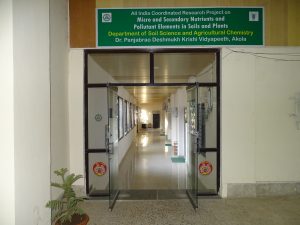 |
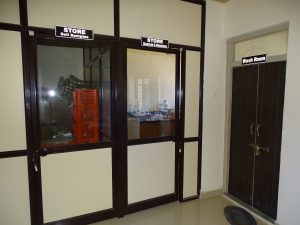 |
|
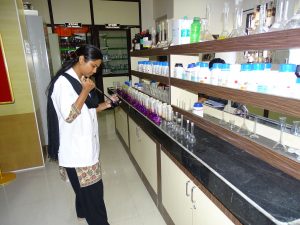 |
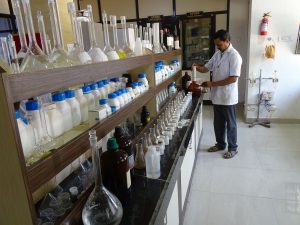 |
|
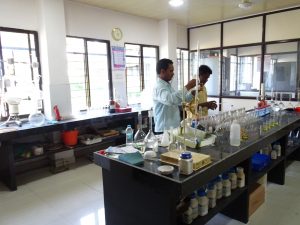 |
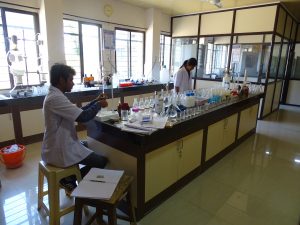 |
|
|
Laboratory of AICRP on Micro and Secondary Nutrients and Pollutant Elements in Soils and Plants |
||
- Atomic Absorption Spectrophotometer
Advanced Atomic Absorption Spectrometer with Graphite Furnace and Hydride Generator
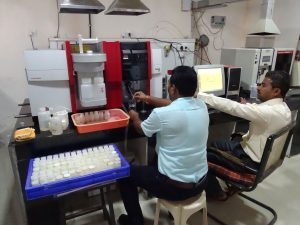
Analysis work on Advanced Atomic Absorption Spectrometer on flame technique
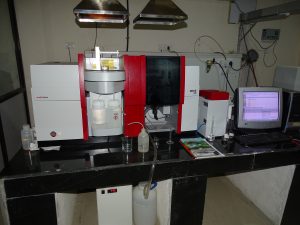
Analysis work on Advanced Atomic Absorption Spectrometer on graphite furnace technique
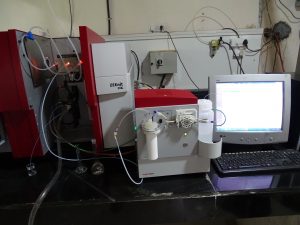
Analysis work on Advanced Atomic Absorption Spectrometer on hydride generator technique
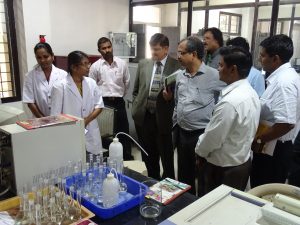
Visit of Accreditation team
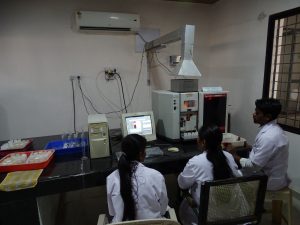
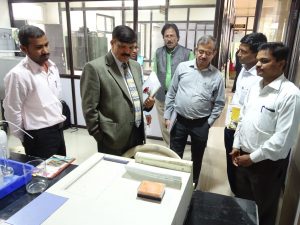
Visit of Accreditation team
- PC based UV – VIS spectrophotometer
- KEL PLUS Automatic Nitrogen / Protein Estimation System and Scrubber System
- Orbital Shaking Incubator
- Muffle furnace
- Oven
- Analytical electronic balance
- pH meter
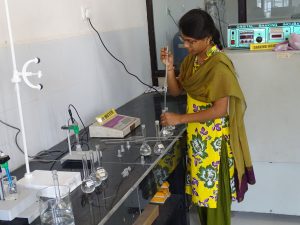
- EC and TDS meter
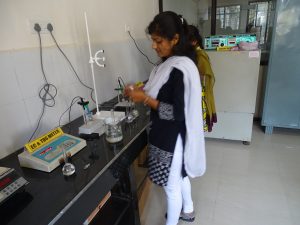
- Double Distillation Water Unit
- Quartz Double Distillation Water Unit for Boron
- Hot plate
- Hot Water bath
Mandate
- Reassessment of micro and secondary nutrients (MSN) deficient/toxic areas by soil and plant analysis as well as through biological responses of crop in different soils.
- Micro and secondary nutrient indexing for forecasting emerging micro and secondary nutrients disorders and developing decision support system under different soil- cropping- management systems.
- Standardize suitable soil test methods and establish critical levels for micro and secondary nutrients and heavy metal toxicities in different soils and crops.
- Developing suitable technique for increasing nutrient use efficiency including organic manures, sewage and sludge added for ameliorating the MSN deficiencies in crops and soils.
- Monitoring heavy metal pollution and trace element toxicities in soils, plant and animal health.
- Identification of deficiency/toxicity symptoms for diagnosing micro and secondary nutrient deficiencies in field crops.
- Effect of phasing of Zn and B application on fate of Zn and B pools in different soils and cropping systems.
- Identifying mechanism of micronutrient interactions in soils and their role in reproductive physiology of plants.
- Screening of crop species and genotypes tolerant to micronutrient stress and heavy metal toxicities.
- Delineation of micro and secondary nutrient deficient areas using GPS/GIS in acid soils of humid and subhumid regions and alkaline alluvium soils of arid and semi arid regions in the states so far remained uncovered.
Research Activities and Achievements
| PROJECT NO. 1 | : | Reassessment and delineation of micro and secondary nutrient deficient or toxic areas and updating soil fertility maps. |
| Objectives | : | 1. To assess the changes in micronutrient fertility of Zn, Cu, Fe and Mn and delineate soils having deficient and toxic amounts of B, Mo, Co and S, based on soil and plant analyses and response to crops to their application.
2. To prepare soil fertility maps depicting extent of deficiency and toxicities of the micronutrients in soils using GIS. |
| Programme 1 | : | Reassessment of micro- and secondary- nutrient deficient or toxic areas and delineation of single and multi- nutrient deficient areas through soil and plant analysis for soil fertility mapping. |
| Programme 2 | : | Reassessment micronutrient deficiency and demonstration of responses to micronutrients of crops under field conditions. |
| PROJECT NO. 2 | : | Forecasting and monitoring the emergence of nutrient deficiencies in areas of exploitive agriculture through Nutrient Indexing in well defined Soil-Crop-Management Systems in different Agro ecological zones. |
| Objective | : | Forecasting the emergence of micro- and secondary- nutrient deficiencies or toxicities in crops and soils resulting from intensive cropping, increased use of fertilizers, changing cropping pattern and management practices etc. |
| Programme 3 | : | Nutrient Indexing for forecasting and monitoring the emergence of nutrient deficiencies in areas of exploitive agriculture in well defined Soil-Crop- Management Systems in different Agro ecological zones. |
| PROJECT NO. 3 | : | Development of techniques for increasing the fertilizer use efficiency of zinc, boron, copper, molybdenum in micro- and secondary- nutrients in major soils and cropping systems |
| Objectives
|
: | To enhance nutrient use efficiency of micronutrients for ameliorating micronutrient deficiencies with low cost |
| Programme 4 | : | Development of suitable technology for micronutrients using nanotechnology for improving efficiency of amelioration of deficiency in major crops. |
| Programme 5 | : | Management of micro and secondary nutrient rates and mode of application and frequency of application to crops or cropping systems in well defined soil types ( boron, copper, molybdenum )
|
| PROJECT NO. 4 | : |
Evaluation of influence of Calcium, Magnesium and Sulphur Nutrition on Yield of important Crops in India
|
| Programme 6 | : | Evaluation of interactive efficiency of calcium, magnesium and sulphur nutrition and yield of different crops. |
| Objectives
|
: | To Evaluate interactive efficiency of calcium, Magnesium and Sulphur Nutrition of different crops and their effect on increasing crop productivity in Indian Soils.
|
| PROJECT NO. 5 | : | Screening of varieties of various cereal, millets, pulses and vegetable crops for tolerance to micronutrient stress and understanding the mechanism of enrichment of nutritionally important micronutrients like zinc, iron, manganese and copper in seed and fodder. |
| Programme 7 | : | Screening of varieties of cereals, pulses and millets for tolerant to micronutrient stress and understanding the mechanism of micronutrient enrichment in the status of some nutritionally important micronutrients in important food crops. |
| Objectives
|
: | To study the variability across locations in the cultivars of various cereals, millets, pulses and vegetable crops for the content of nutritionally important micronutrients- zinc in seed and fodder. |
| Programme 8 | : | Quantifying role of micronutrients in enhancing major nutrient use efficiency and crop productivity. |
| Objective | : | To quantify the role of micronutrients in enhancing NPKS, nutrient use efficiency and crop productivity. |
| PROJECT NO. 6 | : | Role of organic manures, green manures and sewage sludge in correcting the micro-and secondary-nutrient deficiencies. |
| Programme 9 | : | Developing IPNS technology for ameliorating micro- nutrient deficiencies in cropping system. |
| Objective | : | To develop suitable IPNS technology for ameliorating micro- nutrient deficiencies. |
| PROJECT NO. 7 | : | Monitoring health hazards from heavy metals and trace elements in soils and plants and developing techniques for in situ management |
| Programme 10 | : | Assessment of nature and extent of pollution in agricultural soil and plants through sewage, sludge and industrial effluents in major cities and developing techniques for in-situ management. |
| Objective | : | · Preparation of inventories about the receiving source and rate of effluents, municipal waste, sewage water etc. in different important cities in Maharashtra.
· Quantify the nature and build up of heavy metal upto toxic levels in soils for plant growth (selected crops). |
| PROJECT NO. 8 | : | BASIC RESEARCH |
| Programme 11 | Effect of phasing (frequency) of Zn application on fate of zinc pools in Vertisols under cotton and soybean rotation. | |
| Objective | · To study the response of cotton and soybean rotation to zinc application
· To study the Effect of phasing (frequency) of Zn application on different Zn pools in soil. |
|
| Programme 12 | : | Assessment of periodic accreditation of sulphur in soil and its movement soil profile. |
| Objective | : | To forecast emergence of sulphur deficiencies and vertical distribution in soil under major cropping system in various agro-ecological region. |
| Programme 13 | : | Monitoring hazards from heavy metals or trace elements pollution or toxicity to plant, animal and human health |
| Objective | : | To study the transfer of the heavy metals accumulation from soil –plant – animal-human chain
|
| Programme 14 | : | Refinement of critical levels of micro and secondary nutrients in soils and plants |
| Objective | : | To refine the critical levels of micro and secondary nutrients in soils and plants |
Achievements
Percent samples deficient (PSD) of soil in secondary and micro nutrients in Vidarbha, Marathwada and Konkan region.
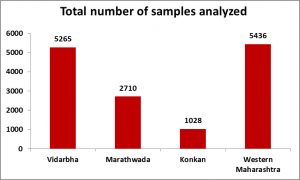
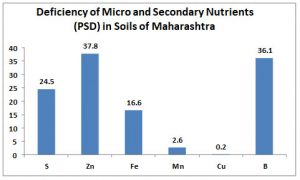
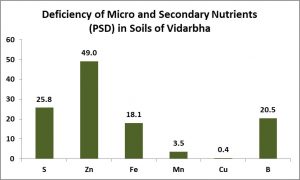
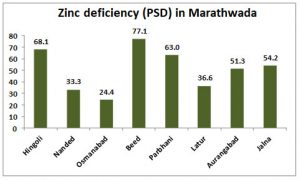
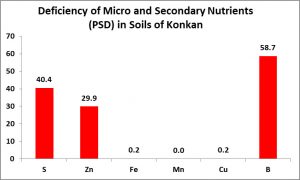
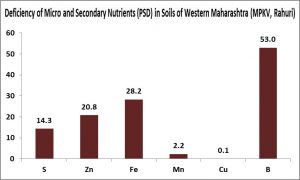
Sulphur Deficiency
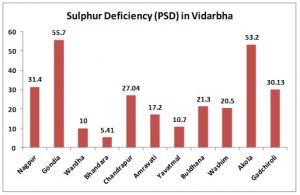
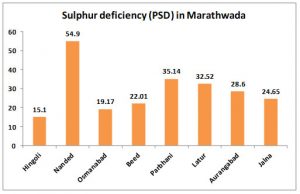
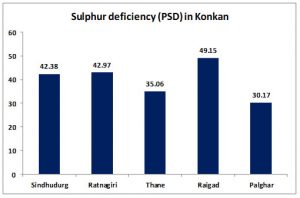
Zinc Deficiency
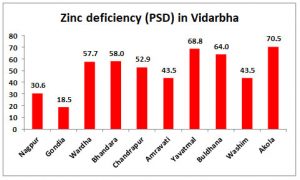

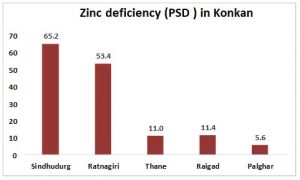
Boron Deficiency
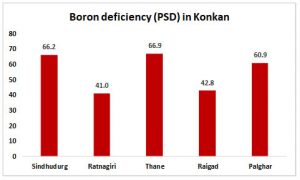
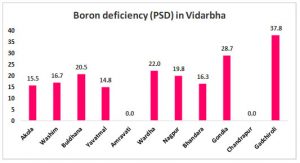
Recommendations
| 1 | Soil application of zinc sulphate @ 10 kg ha-1 is recommended if the available zinc content of soil at the time of sowing is below 0.64 ppm to cotton grown on Vertisols. |
| 2 | Foliar application of 0.5 % zinc sulphate along with 0.4 % lime is recommended for cotton grown on Vertisols if the zinc concentration in index leaf is below 21 ppm. |
| 3 | For cotton crop, critical limit of iron in soil and in plant (fully mature leaves) is recommended as 4.5 ppm for soil and 281 ppm for plant. |
| 4 | It is recommended that soybean seeds should be treated with Rhizobium + PSB (each 25 g kg-1 seed) and 4 g ammonium molybdate per kg seed alongwith recommended dose of chemical fertilizer. |
| 5 | For obtaining maximum yield and higher B:C ratio of soybean – mustard cropping sequence on zinc deficient soil, FYM @ 3 t ha-1 + 50 per cent recommended dose of chemical fertilizers (15:37.5 kg N and P) + 10 kg ZnSO4 ha-1 with Rhizobium and PSB to soybean and 50 kg N + 20 kg P ha-1 + PSB should be applied to mustard. |
| 6 | Application of 15 t FYM ha-1 + 40:60:40 kg NPK ha-1 + 25 kg sulphur ha-1 through gypsum should be applied alongwith 0.2 per cent borax spray during flowering for obtaining maximum yield of sunflower. |
| 7 | For obtaining higher yield of soybean and enhancing use efficiency of N and P the seed treatment with Zinc sulphate (9.5 g) + ammonium molybdate (1.8 g) + cobalt sulphate (2.5 g) per kg seed before sowing is recommended for zinc, molybdate and cobalt deficient soils. |
| 8 | For obtaining higher seed cotton yield, monetary returns, nutrient use efficiency and improvement in soil fertility, application of 75 % recommended dose of fertilizers (75: 37.5: 37.5 NPK kg ha-1) along with micronutrients (3 kg Zn ha-1 + 3.75 kg Fe ha-1) in the form of water soluble fertilizers through drip in five splits (At sowing, 35, 55, 75 and 95 DAS) is recommended for hybrid cotton in Vertisol. |
| 9 | In zinc and boron deficient medium, deep black soils for obtaining higher yield of maize, improvement in grain quality, nutrient use efficiency and monetary returns as well as improvement in soil fertility status, application of zinc @ 10 kg ha-1 + boron @ 1 kg ha-1 along with recommended dose of fertilizer (100: 50: 50 kg N, P2O5 and K2O ha-1) is recommended . |
| 10 | In medium deep black soil having deficiency of zinc, foliar application of zinc through zinc sulphate @ 5 g per litre or Zn –EDTA @ 2.5 g per litre at 30, 45 and 60 DAE is recommended for obtaining higher yield of soybean, monetary returns and grain quality as well as N and P use efficiency. |
| 11 | In medium deep soil having deficiency of sulphur and zinc, application of sulphur @ 30 kg ha -1 + zinc @ 2.5 kg ha-1 along with recommended dose N (30 kg ha-1) and P (75 kg ha-1) is recommended for higher yield of soybean, monetary returns, nutrient use efficiency and quality of grain as well as improving soil fertility status. |
| 12 | For obtaining higher yield and economic returns in zinc and boron Vertisols, it is recommended to apply 25 kg zinc sulphate and 5 kg borax alongwith 60 : 30 : 0 NPK kg ha-1 to rainfed American cotton. |
| 13 | Application of 20 kg ZnSO4 ha-1 to medium deep black clay loam soil, low in zinc is recommended for wheat. |
| 14 | Application of Borax @ 5 kg ha-1 for groundnut on sandy clay loam soils every year and for clay loam soils once in two or three years is recommended. |
| 15 | Zinc sulphate @ 20 kg ha-1 is recommended for adsali sugarcane (CO-740) grown on Vertisol deficient in available zinc. |
| 16 | Application of borax @ 10 kg ha-1 is recommended for adsali sugarcane (CO-740) grown on Vertisol deficient in available boron. |
| 17 | For achieving targeted yield of soybean in zinc deficient medium deep black soils, the application of 20 kg ha-1 zinc sulphate along with nitrogen, phosphorus and potassium fertilizers is recommended. |
| 18 | The soil application of 20 kg ha-1 zinc sulphate to onion grown on zinc deficient shallow soil along with recommended dose of fertilizer (NPK 100:50:50 + 10 t ha-1 FYM) is recommended. |
| 19 | Two foliar spray of ferrous sulphate (0.5 %) and zinc sulphate (0.5 %) after 30 and 45 DAS along with recommended dose of fertilizer (60 kg N + 80 kg P ha-1) for higher economic yield of French bean in iron and zinc deficient soils of plain zone of Maharashtra. |
| 20 | Soil application of 20 kg ha-1 ferrous sulphate along with recommended dose of fertilizers (NPK 100:50:50 + 10 t ha-1 FYM) is recommended for higher yield and profit of onion on iron deficient soils of Western Maharashtra. |
| 21 | The soil application of ferrous sulphate + zinc sulphate @ 20 kg ha-1 each+ Borax @ 5 kg ha-1 at the time of sowing of okra or foliar sprays of ferrous sulphate + zinc sulphate (0.5% each) + 0.2 % Boric acid at 30 and 45 days after sowing of okra along with recommended dose of fertilizers (FYM 20 t/ha + 100:50:50 N:P2O5:K2O kg/ha) in iron, zinc and boron deficient soil is recommended for higher yield as well as maintaining micronutrient status in the soil. |
| 22 | In Iron and Zinc deficient soils, application of Iron sulphate @10 kg and Zinc sulphate @ 20 kg per hectare along with RDF to Kharif Jowar is recommended for getting better yields. |
| 23 | It is recommended to apply Borax @ 5 kg and Zinc sulphate @15 kg per hectare along with RDF for better yield of Green gram (BM-4) in Boron and Zinc deficient soils. |
| 24 | It is recommended to apply Zinc sulphate @15 kg per hectare along with RDF for getting maximum yield of Red gram (BSMR-736) in zinc deficient soils. |
| 25 | It is recommended to apply Maharashtra state notified multi-micronutrient Grade-I (2%Fe, 1%Mn, 5% Zn, 0.5% Cu and 1% B) @ 125 kgs per hectare (half at bahar treatment and half at fruit development stage) or Grade-II (2.5% Fe, 1% Mn, 3% Zn, 1% Cu, 0.5%B and 0.1% Mo) 5 sprays @ 1% five times in alternate months along with RDF for Sweet Orange orchards above 10 years in Marathwada region for getting beneficial economic yield. |
| 26 | It is recommended to apply 25 kg Zinc sulphate (Soil application) + 0.1 % Boron (1% Borax) spray (65 DAS and 80 DAS) along with 80:40:40 NPK per hectare to Rainfed Cotton for better yield and quality in Zinc and Boron deficient soils. |
| 27 | It is recommended to apply 30 kg Sulphur + 20 kg Zinc sulphate (Soil application) + 2% Fe spray (during 40-50 DAS and 60-70 DAS) alongwith 150:50:50 NPK kg per hectare to Maize for better yield in medium to deep black calcareous soils. |
| 28 | Soil application of FeSO4 @ 25 kg ha-1 + ZnSO4 @ 20 kg ha-1 mix with FYM and nutrient application based on yield targeting equations to Bt cotton in iron and zinc deficient soil is recommended for higher yield, monetary return, minimizing reddening and increase in availability of iron and zinc in Inceptisols of Western Maharashtra. |
| 29 | Soil applications of FeSO4 + ZnSO4 @ 5 kg ha-1 each at sowing and 30 days after sowing with general recommended dose of nutrients to hybrid maize in iron and zinc deficient Entisols of Western Maharashtra is recommended for higher yield, monetary returns and increase in availability of iron and zinc in soils. |
| 30 | Application of general recommended dose of nutrients along with 20 kg FeSO4/ha mix with FYM to turmeric crop for higher yield and maintenance of soil fertility in iron deficient Inceptisols is recommended for western Maharashtra |
| 31 | In iron, zinc and boron deficient soil, application of FeSO4 + ZnSO4 @ 20 kg ha-1 each (50g each per tree) + Borax 5 kg ha-1 (13 g per tree) is recommended at the time of bahar for better yield and quality of fig fruits and for maintaining soil micronutrient status. |
| 32 | Application of micronutrients 25 kg ZnSO4 + 20 kg FeSO4 ha-1 in addition to recommended dose of fertilizers in Bt cotton is recommended for higher seed cotton equivalent yield and profit. |
| 33 | The continuous irrigation using untreated sewage effluents leads to accumulation of heavy metals in soils and crops and therefore the use of untreated sewage effluents should be prohibited for irrigating the vegetable and field crops in urban / peri-urban areas and along the polluted river banks in Maharashtra. |
| 34 | It is recommended to apply boron @ 4 kg ha-1 (3.0 g per palm tree) through the soil application with recommended dose of reduce the Arecanut cracking in the Konkan region. |
| 35 | It is recommended to grow groundnut with the soil application of 20 kg ZnSO4 ha-1 along with recommended dose of fertilizer (25 kg N + 50 kg P2O5) for obtaining maximum yield with higher net returns during Kharif season under South Konkan conditions. |
| 36 | For soybean crop, the critical levels of zinc is recommended as 0.65 mg kg-1 in soil and 24 mg kg-1 in plant at grand growth stage, useful for zinc management in medium deep swell-shrink soils. |
| 37 | In zinc and iron deficient soils, for obtaining higher yield of sweet orange and improvement in fruit quality, soil application of Zn-EDTA @ 50 g /tree and Fe-EDTA @ 100 g /tree or one foliar spray of Zn-EDTA @ 0.5 % and Fe-EDTA @ 1.0 % one month after fruit set along with recommended dose is recommended. |
| 38 | Foliar spray of 0.5% magnesium sulphate at 30 days after sowing while in micronutrient deficient soils, spray 0.2% boric acid or 0.5% zinc sulphate or 0.5% ferrous sulphate, as per need at 40 days after sowing to pea (rabi) along with general recommended dose of fertilizer (10 t FYM ha-1 + 25:60:60 N:P2O5:K2O kg ha-1) is recommended for shallow and medium deep black soils in Plain zone of Maharashtra on the basis of higher yield and monetary returns. |
| 39 | The soil application of micronutrient, 35 g Ferrous sulphate + 30g Zinc sulphate +10 g Borax along with 50 kg FYM per plant in addition to recommended dose of fertilizers is recommended at initiation of bahar treatment for better yield & quality of pomegranate fruits. |
| 40 | The application of zinc sulphate @ 20 kg ha-1 incubated for one week with cow dung slurry (1:4 fresh cow dung : water ratio) at 30 days after sowing through irrigation to rabi sorghum with general recommended dose of nutrients (80:40:40 kg ha-1 N: P2O5: K2O + 5 t ha-1 FYM) is recommended in zinc deficient medium deep black soils of Western Maharashtra for increase in nutrient use efficiency, uptake of micronutrients, yield, returns and enhancing soil fertility. |
| 41 | The application of general recommended dose of nutrient with soil application of ferrous sulphate and zinc sulphate @ 20 kg ha-1 each (incubated in FYM for 15 days) at the time of transplanting is recommended for higher yield of cabbage, returns and maintaining iron and zinc status in iron and zinc deficient medium deep black soils of Western Maharashtra. |
| 42 | The application of borax @ 5 kg ha-1 at the time of transplanting with general recommended dose of nutrients (10 t FYM ha-1, 56 kg N and 30 kg P2O5 through Urea-DAP briquettes (170 kg) and 50 kg K2O ha-1) is recommended in boron deficient soils of Western Ghat Zone of Maharashtra for higher yield and returns of lowland paddy. |
| 43 | The application of general recommended dose of wheat (120:60:40 N:P2O5:K2O kg ha-1 and FYM @10 tha-1) with soil application of incubated ferrous sulphate @ 20 kg ha-1 (incubated in 100 kg FYM for 15 days) is recommended for higher yield, returns and iron availability in iron deficient soils of Plain zone of Western Maharashtra. |
| 44 | The application of foliar spray of EDTA-Zn and EDTA-Fe each @ 0.5 per cent at 2nd and 4th month after planting and soil application of zinc sulphate and ferrous sulphate each @ 15 g plant-1 by incubating in FYM in two splits at 5th and 7th month after planting with recommended dose of nutrient is recommended for higher yield and quality banana in medium deep black soils. |
| 45 | In medium deep black soils having sulphur and zinc deficiency application of sulphur @ 30 kg ha -1 + zinc @ 2.5 kg ha– 1 along with recommended dose nitrogen (30 kg) and P2O5 (75 kg /ha) is recommended for higher yield, nutrient uptake, nutrient use efficiency, grain quality of soybean as well as improving soil fertility status. |
| 46 | In zinc deficient medium deep black soils for obtaining higher productivity of soybean, monetary return, uptake of nutrients, improved quality of grain and use efficiency of N and P, the foliar application of zinc through zinc sulphate @ 5 g lit-1 or zinc-EDTA @ 2.5 g lit-1 at 30, 45 and 60 DAE is recommended. |
| 47 | In zinc and boron deficient medium deep black soils for obtaining higher productivity of maize, uptake of nutrient and improved grain quality, nutrient use efficiency and nutrient recovery as well as monetary returns the soil application of zinc @ 10 kg ha-1 and boron @ 1 kg ha-1 along with recommended dose (100: 50 : 50 kg ha-1 Nitrogen, Phosphorus and Potassium) is recommended. |
| 48 | For soybean crop, the critical levels of zinc is recommended as 0.65 mg kg-1 in soil and 24 mg kg-1 in plant at grand growth stage, useful for zinc management in medium deep black swell-shrink soils. |
| 49 | In zinc and iron deficient soils of Maharashtra, for obtaining higher yield of sweet orange and improvement in fruit quality, soil application of Zn-EDTA @ 50 g /tree and Fe-EDTA @ 100 g /tree or one foliar spray of Zn-EDTA @ 0.5 % and Fe-EDTA @ 1.0 % one month after fruit set along with recommended dose is recommended. |
| 50 | In sulphur deficient soil, for obtaining higher onion bulb yield and monetary returns and nutrient use efficiency, besides improving soil fertility, soil application of sulphur @ 45 kg /ha through gypsum or sulphur @ 30 kg/ha through bentonite-S alongwith recommended dose (10 t FYM + 100 : 50 : 50 kg / ha N, P2O5 and K2O) is recommended. |
| 51 | In sulphur deficient soils, application of 30 kg Sulphur ha-1 through gypsum (250 kg) or bentonite-sulphur (35 kg) along with RDF (60 : 30 : 30 kg NPK ha-1) is recommended to increase the productivity and oil content of Bt cotton under rainfed situation. |
| 52 | In zinc deficient medium deep black soil, for obtaining higher grain yield of chickpea, nutrient uptake, quality of grain and higher monetary returns besides improving soil fertility, soil application of zinc sulphate @ 20 kg ha-1 or two foliar sprays of zinc sulphate @ 0.50 % during flowering and grain filling stage along with recommended dose of fertilizer (20:50:30 kg ha-1 N, P2O5& K2O) is recommended. |
| 53 | For chickpea crop, the levels of zinc 0.64 mg kg-1 in soil and 23.03 mg kg-1 in plant at grand growth stage are recommended as critical levels useful for zinc management in swell shrink soils. |
(Source : Dr. PDKV, Akola, MPKV, Rahuri, VNMKV, Parbhani and Dr. BSKKV, Dapoli)
Research and Extension Linkage
a. Front line demonstrations
Several FLD’s were conducted on farmers field located in different districts of Maharashtra with the objectives
- To disseminate the technologies on micronutrients among the farmers
- To educate them about application of micro and secondary nutrients to crops on deficient soils .
The crops grown were paddy, cotton, maize, soybean, wheat, chickpea and millets.
The highest response of soil application of zinc was noticed in paddy and maize on Zn deficient soils. The response of Zn application on deficient soils was higher as compared to marginal soils.
Table: Crop response to S, Zn and Fe application (Field studies on farmers’ fields)
| Crops | No. of FLD | Mode of application | Per cent increase in yield over control |
|---|---|---|---|
| Sulphur | |||
| Cotton | 45 | Soil application | 15-25 |
| Soybean | 57 | Soil application | 10-28 |
| Zinc | |||
| Cotton | 52 | Soil application | 4 – 15 |
| Soybean | 60 | Soil application | 5 – 16 |
| Paddy | 71 | Soil application | 4 – 16 |
| Wheat | 98 | Soil application | 2 – 20 |
| Maize | 5 | Soil application | 9 – 19 |
| Millets | 11 | Soil application | 3 – 9 |
| Chickpea | 51 | Soil application | 7 – 17 |
| Chickpea | 10 | Foliar (Zn- EDTA) | 3 – 8 |
| Iron | |||
| Chickpea | 13 | Foliar (Fe- EDTA) | 3– 10 |
Table : Year and location wise number of FLDs conducted on different crops
| Sr. No. | Year | Particulars | No. of FLD’s | Place |
|---|---|---|---|---|
| 1 | 2000-01 | FLD’s on cotton organized on different recommended package of practices of
cotton on farmers field |
100 | Various districts of Vidarbha region |
| 2 | 2001-02 | 50 | ||
| 3 | 2002-03 | 30 | ||
| 4 |
2003-04 |
30 | ||
| 5 | Demonstrated the technology generated in long term experiment of soybean- wheat cropping sequence on farmers field through experiments on cultivators field (ECF) | 5- ECF’s | ||
| 6 | 2009-10 | Response of wheat to soil application | 10 | Akola district |
| 7 | 2010-11 | Response of Paddy to soil application of zinc | 10 | Ladbori, Chandrapur dist. |
| 8 |
2011-12 |
Response of paddy to soil application of zinc | 05 | Gadchiroli district |
| 9 | Response of wheat to soil application of zinc in tribal area | 15 | Tq: Patur, Dist Akola
and Tq Dharni Dist. Amaravati |
|
| 10 | Response of chickpea to foliar application of zinc to tribal area | 10 | Tq: Patur, Dist Akola and Tq Dharni Dist. Amaravati | |
| 11 | Response of chickpea to foliar application of iron in tribal area | 05 | Tq Dharni Dist. Amaravati | |
| 12 |
2012-13 |
Response of paddy to soil application of zinc | 05 | Jabhali Sadak, Tah. Sakoli, Dist. Bhandara |
| 13 | Response of soybean to soil application of zinc | 05 | At. Bharwadi
Tah. Tiwasa Dist. Amaravati |
|
| 14 | Response of millets to soil application of zinc | 11 | Chikkaldhara Dist Amaravati.
|
|
| 15 | Response of wheat and chickpea to soil application of zinc in tribal area | 20 | Chikkaldhara Dist Amaravati.
|
|
| 16 | Response of wheat and chickpea to soil application of zinc | 20 | Nandurbar district | |
| 17 |
2013-14 |
Response of paddy to soil application of zinc | 20 | Village : Belgata, Tq: Mul, Dist: Chandrapur and Village : Kotgal, Tq & Dist: Gadchiroli |
| 18 | Response of soybean to soil application of zinc | 10 | Village : Tembhrusonda,
Tq: Chikhaldara, Dist. Amravati |
|
| 19 | Response of Little millet to soil application of zinc | 05 | Village : Chandpur, Tq: Chikhaldara,
Dist. Amravati |
|
| 20 | Response of wheat to soil application of zinc | 10 | Village : Chandpur, Tq: Chikhaldara, Dist. Amravati”
|
|
| 21 | Response of chick pea to soil application of zinc | 05 | Village : Tembhrusonda,
Tq: Chikhaldara, Dist. Amravati |
|
| 22 |
2014-15 |
Response of cotton to soil application of zinc | 15 | Village : Mandawa , Tq. Chandur (Railway)
Dist. Amravati |
| 23 | Village : Daroda, Tq. Hinganghat, Dist. Wardha | |||
| 24 | Village : Peth Kaldongri Tq. Dist. Nagpur | |||
| 25 | Response of soybean to soil application of zinc | 12 | Village : Tuljapur Tq. Chandur (Railway)
Dist. Amravati |
|
| 26 | Village : Nandora Tq. Katol, Dist. Nagpur | |||
| 27 | Village : Jam, Tq. Samudrapur, Dist. Wardha | |||
| 28 | Village : Tandulwadi
Tq. Risod, Dist. Washim |
|||
| 29 | Response of soybean to soil application of sulphur | 7 | Village : Gobhani
Tq. Risod, Dist. Wsahim |
|
| 30 | Response of paddy to soil application of zinc | 11 | Village : Temni Tq. & Dist. Gondia | |
| 31 | Response of soybean to soil application of zinc | 5 | Village : Chandpur Tq. Chikhaldara
Dist. Amravati |
|
| 32 | Response of Cotton to soil application of zinc | 5 | ||
| 33 | Response of Cotton to soil application of zinc | 14 | Village : Chandpur Tq. Chikhaldara, Dt. Amravati | |
| 34 | Response of chickpea to soil application of zinc | 4 | Village : Chandpur Tq. Chikhaldara, Dt. Amravati | |
| 35 |
2015-16 |
Response of soybean to soil application of zinc | 02 | At. Chikhali & Zakalwadi
Dist. Washim |
| 36 | 04 | At. Bhisani, Tq. & Dist. Yavatmal | ||
| 37 | Response of soybean to soil application of sulphur | 05 | At. Bramhanwada, Tq. Ner, Dist. Yavatmal | |
| 38 | Response of Cotton to soil application of zinc | 06 | At. Bhisani, Tq. & Dist. Yavatmal | |
| 39 | 05 | At. Bramhanwada,Tq. Ner, Dist. Yavatmal | ||
| 40 | Response of soybean /cotton to soil application of zinc | 10 | At. Chandpur, Tq. Chikhaldara
Dist. Amravati |
|
| 41 | 05 | At. Bahadurpur, Tq. Chikhaldara
Dist. Amravati |
||
| 42 | 05 | At. Bhilkheda, Tq. Achalpur
Dist. Amravati |
||
| 43 | Response of paddy/ wheat to soil application of zinc | 15 | At. Adpalli & Dibhana, Tq. & Dist. Gadchiroli | |
| 44 | 07 | At. Patur Nandapur, Tq. & Dist. Akola
At. Goregaon & Gazipur, Tq. Murtizapur, Dist. Akola |
||
| 45 | Response of wheat/chickpea to soil application of zinc | 12 | At. Patur Nandapur, Tq. & Dist. Akola
At. Goregaon & Gazipur, Tq. Murtizapur, Dist. Akola |
|
| 46 | 12 | At. Mangurda, Tq. Kelapur, Dist. Yavatmal
At. Jalalkheda, Kelapani, Hirdamal, Tq. Chikhaldhara, Dist. Amravati |
||
| 47 | 09 | At. Mangurda, Tq. Kelapur, Dist. Yavatmal
At. Jalalkheda, Kelapani, Hirdamal, Tq. Chikhaldhara, Dist. Amravati |
||
| 48 | 2016-17 | Response of soybean to soil application of sulphur | 15 | At. Madakhed Bk. Tq. Jalgaon Jamod, Dist. Buldhana
At. Mangurda, Tq. Kelapur, Dist. Yavatmal |
| 49 | Response of Cotton to soil application of zinc | 15 | At. Mangurda, Tq. Kelapur, Dist. Yavatmal | |
| 50 | Response of paddy to soil application of zinc | 10 | At. Ramala & Bhendala, Tq: Sindewahi, Dist. Chandrapur | |
| 51 | Response of wheat/chickpea to soil application of zinc | 17 | At. Takarkheda More, Tq. Anjangaon Surji, Dist. Amravati |
b. Field days organized
The field days were organized on the farmers field to disseminate the knowledge and importance of micro and secondary nutrients among the farming community. The demonstrations were also visited by the farmers.
| S. N. | Title | Place and Date |
|---|---|---|
| 1 | Response of zinc application to paddy crop
by AICRP on Micronutrients |
Village : Ladbori ,Tq. Sindewahi Dist. Chandrapur
October 29, 2011 |
| 2 | Organized Field day on “Micro and Secondary Nutrients application for crop production” by AICRP on Micronutrients | At Andhar Sawangi, Tq. Patur Dist. Akola, January 29, 2012 |
| 3 | Organized Field day on “Micro and Secondary Nutrients application for crop production” by AICRP on Micronutrients, | At Dabida, Tq. Dharni Dist. Amravati, March 28, 2012 |
| 4 | Field day on “Use Micronutrients in Soybean Crop” organized by AICRP on Micronutrients, | At. Bharwadi, Tq. Tiwasa
Dist. Amaravati September 7, 2012 |
| 5 | Field day on “Balanced fertilization for sustaining cotton productivity with a special emphasis on potassium in Vertisols” organized under potash project | At. Alanda Dist: Akola
October 28, 2012 |
| 6 | Field day on “Use of zinc application to paddy” organized by AICRP on Micronutrients, | Jambhali Sadak, Tq. Sakoli
Dist. Bhandara, November, 07 2012 |
| 7 | Field day on “Use of Micronutrients under TSP” organized by AICRP on Micronutrients, | At. Tembru Sonda, Tq. Chikhaldhara, Dist Amravati. March 22, 2013 |
| 8 | Field Day Organized “Use of Zinc sulphate in soybean” by AICRP on Micronutrients | At Mothegaon, Tq. Risod, Dist. Washim, Date : Oct 1, 2013 |
| 9 | Field Day Organized “Use of Micronutrients under TSP” by AICRP on Micronutrients | At Chandpur, Tq. Chikhaldara Dist. Amravati, Date : Oct 16, 2013 |
| 10 | Field Day Organized “Use of sulphur in soybean” by AICRP on Micronutrients | At Gobhani, Tq. Risod, Dist. Washim, Date : Sept 20, 2014 |
| 11 | Field Day Organized “Use of Micronutrients under TSP” by AICRP on Micronutrients | at Chandpur, Tq. Chikhaldara Dist. Amravati, Date : Feb 9, 2015 |
| 12 | Field Day Organized “Use of sulphur in soybean” by AICRP on Micronutrients | At Chikhali, Tq. Risod, Dist. Washim, Date : Sept. 15, 2015 |
| 13 | Field Day Organized on Site specific nutrient management under IPNI project | At Rahit, Tq. Barshitakli Dist. Akola, Date : Jan. 14, 2016 |
| 14 | Field Day Organized “Use of Micronutrients under TSP” by AICRP on Micronutrients | At Mangurda, Tq. Kelapur,
Dist. Yavatmal, Date : Feb 16, 2016 |
| 15 | Field Day Organized “Use of Micronutrients and sulphur in cotton and soybean by AICRP on Micronutrients | At Madakhed , Tq. Jalgaon Jamod, Dist. Buldhana, Date: Oct. 1, 2016 |
| 16 | Field Day Organized “Use of Micronutrients and sulphur in cotton and soybean by AICRP on Micronutrients | At Sonala, Tq. Sangrampur, Dist. Buldhana, Date: Dec. 8, 2017 |
c. Distributed Soil Health Cards to Farmers
Soil health cards distributed to tribal farmers in Chandpur, Teh:Chikhaldara, Dist: Amravati and to the FLD farmers.
d.Micronutrient fertilizers distributed (Zinc sulphate) to the tribal farmers in villages of tribal areas of Amravati and Yavatmal districts
e. Farmers training organized
The farmers training at university and farm level / village level were also conducted.
| S. N. | Training | Place | Date |
|---|---|---|---|
| 1 | Use of micronutrients for enhancing crop productivity | Organized training programme for farmers of Baitul district (M.P.) at Shetkari Sadan, organized by AICRP on Micronutrients, Dept. of SSAC, Dr. PDKV., Akola | February 21 to March 01, 2012 |
| 2 | Farmers Training on Use of
Micronutrients in Tribal area |
KVK, Gadchiroli, organized
by AICRP on Micronutrients |
March 3, 2012 |
| 3 | Training programme on Use of micronutrients for enhancing crop productivity | Shetkari Sadan, Dr. PDKV, Akola organized by AICRP on Micronutrient | January 7- 11, 2013 |
| 4 | Training programme on management of micronutrients in tribal area (TSP) | KVK, Sonapur, Gadchiroli.
organized by AICRP on Micronutrients |
March, 25 2013 |
| 5 | Organized training of tribal farmers for Micronutrient Management in Paddy organized under AICRP on Micronutrients | Belgata, Tq. Mul, Dist. Chandrapur | January 7, 2013 |
| 6 | Organized Training of farmers from Baitul district, MP on Management of Micronutrients for enhancing crop productivity in collaboration with Director of Extension Education and Department of Soil Science & Agril. Chemistry, Dr. PDKV., Akola. | Shetakari Sadan, Dr. PDKV, Akola | March 24-28, 2014 |
| 7 | Organized farmers training programme on “Response of paddy to zinc application” under AICRP on Micronutrients | At. Temani, Tq. Gondia
Dist. Gondia |
November 14, 2014 |
| 8 | Organized training on ” Use of Micro and Secondary nutrients for Enhancing Crop Productivity” by AICRP on Micronutrients under TSP | Dr. PDKV, Akola | January17-21, 2015 |
| 11 | Farmer Training organized under IPNI project | At. Rahit,Tq. Barshitakli
Dist. Akola |
January 14, 2016 |
| 12 | Organized farmer Training on Micronutrient management organized under AICRP on Micronutrient | At. Mangurda, Tq. Kelapur,
Dist. Yavatmal |
February 16, 2016 |
f. National Workshop organized
Organized 27th National Workshop of All India Coordinated Research Project on Micro and Secondary Nutrients and Pollutant Elements in Soils and Plants during March 7-9, 2014.
Publications
a) Research Bulletins
| Sr. No. | Title | Date |
|---|---|---|
| 1 | Research Bulletin on GIS Based Soil Fertility Assessment for Soil Health Sustenance | Tech.Bull/Dr.PDKV/Pub/325/2013 |
| 2 | Research Highlights on Micro and Secondary Nutrients | Tech.Bull/Dr.PDKV/Pub/371/2014 |
| 3 | Geographical Information System Based Scenario of Micro and Secondary Nutrients in Maharashtra | No. Dr.PDKV/Pub/ 491/2017 |
| 4 | शाश्वत शेतीसाठी सुक्ष्म व दुय्यम अन्नद्रव्यांबाबत विस्तार विषयक कार्य | No. Dr.PDKV/Pub/ 473/2017 |
| 5 | Geographical Information System Based Scenario of Micro and Secondary Nutrients in Maharashtra | No. Dr.PDKV/Pub/ 491/2017 |
b) Folders/leaflets (In Marathi)
| Sr. No. | Title | Date |
|---|---|---|
| 1 | Potash: Importance in balance nutrition. | No. Dr.PDKV/Publ./665/ March,2012 |
| 2 | Sulphur: Importance in balance nutrition. | No. Dr.PDKV/Publ./666/ March,2012 |
| 3 | Soil management practices for sustainable agriculture. | No. Dr.PDKV/Publ./667/March,2012 |
| 4 | Micro and secondary nutrient deficiency symptoms. | No. PDKV/PUB/Micro/800/2014
|
| 5 | Recommendation of micro and secondary nutrients for crops in Maharashtra. | No. PDKV/PUB/Micro/799/2014 |
| 6 | Balance fertilization for sustainable agriculture. | No. PDKV/PUB/Micro/835/2014 |
| 7 | Farmer’s field trial- demonstration and Technology. | No. PDKV/PUB/Micro/836/2014 |
c) Booklets (In Marathi)
| Sr. No. | Title | Date |
|---|---|---|
| 1 | Soil health and fertility management in Akola district. | No. Dr.PDKV/Publ./ 655/ March,2012 |
| 2 | Soil health and fertility management in Buldhana district | No. Dr.PDKV/Publ./ 656/ March,2012 |
| 3 | Soil health and fertility management in Yavatmal district | No. Dr.PDKV/Publ./ 657/ March,2012 |
| 4 | Soil health and fertility management in Bhandara district | No. Dr.PDKV/Publ./ 658/ March, 2012 |
| 5 | Soil health and fertility management in Washim district | No. Dr.PDKV/Publ./ 314/ March, 2013 |
| 6 | Soil health and fertility management in Amravati district | No. Dr.PDKV/Publ.
/315/ March, 2013 |
| 7 | Soil health and fertility management in Chandrapur district | No. Dr.PDKV/Publ. /316/ March, 2013 |
| 4 | Zinc management in Vidharbha soils | No.Dr.PDKV/Publ/320/2013 |
| 5. | Sulphur survey and management for Sustainable crop production in Vidharbha soils | No.Dr.PDKV/Publ/321/2013 |
| 6. | Green manuring for sustainable soil health | No.Dr.PDKV/Publ/322/2013 |
| 7. | Potash management for sustainable farming | No.Dr.PDKV/Publ/323/2013 |
| 9 | Micro and secondary nutrient functions, deficiency and control measures (Marathi) | No. Booklet/Dr. PDKV, Akola/PUB/ 370/2014 |
| 10 | GIS based soil fertility management (Marathi) | No. Booklet/Dr. PDKV, Akola/PUB/ 373/2014 |
| 11 | Soil health and fertility management in Nagpur district | No. Dr.PDKV/Pub/ 457/2017 |
| 12 | Soil health and fertility management in Wardha district | No. Dr.PDKV/Pub/ 458/2017 |
| 13 | Soil health and fertility management in Gondia district | No. Dr.PDKV/Pub/ 459/2017 |
Contact Information
Dr. Rajendra N. Katkar
Scientist Incharge and Professor
AICRP on Micro and Secondary Nutrients and Pollutant Elements in Soils and Plants.
Dr. Panjabrao Deshmukh Krishi Vidyapeeth,
Akola – 444 104 (Maharashtra).
Phone: (+91) – (0724) 800010
Fax : (+91) – (0724) 2258419
Email: micro_soil@pdkv.ac.in
